Learn how to make tamales right at home with these simple step-by-step instructions! This authentic Mexican tamales recipe is filled with tender pieces of pork simmered in a delicious red chile sauce wrapped in a soft and fluffy masa dough.
If you love this version, then you’ll also love my chicken tamales, sweet tamales, tamales de rajas, bean and cheese tamales, and tamales de elote.
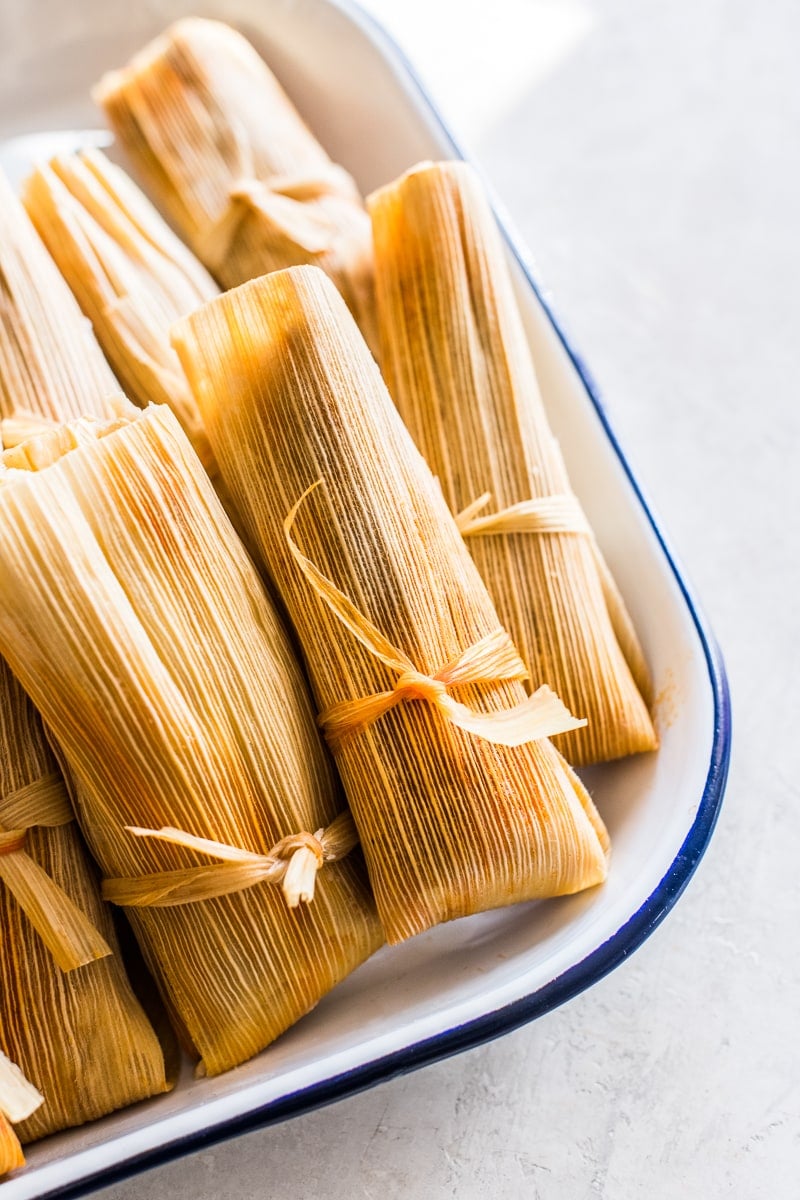
I grew up making tamales every year with my family for Christmas, New Year’s, and other special occasions. It’s one of the most iconic traditional Mexican dishes there is, and every family and region in Mexico has their own unique way of making them.
My Mom was kind enough to walk me through her recipe, and I carefully wrote down everything she did in an easy-to-follow step-by-step format so I could pass it on to my daughter and generations to come.
This is how I grew up making them, and I hope you love them as much as I do!
What Are Tamales?
Tamales are a traditional Mexican dish made using a nixtamalized corn dough called “masa.” The masa is spread onto a corn husk or banana leaf and then filled with a variety of sweet or savory ingredients, including meats, cheeses, peppers, fruits, or other ingredients. The tamales are then wrapped in the same corn husk or banana leaf and steamed until they’re fully cooked through.
Tamales and their fillings vary from region to region. One of the most popular varieties is red chile pork tamales (tamales rojos), which is what I made here.
Did You Know?
Making tamales can be time-consuming. Although not difficult, it involves many steps that can take up a whole day.
That’s often why many families host “tamaladas,” or gatherings where friends and family come together to help in the tamale-making process. This event is often more than just cooking; it’s a cultural tradition that involves bonding, storytelling, and preserving culinary traditions important to many Mexican and Mexican-American families.
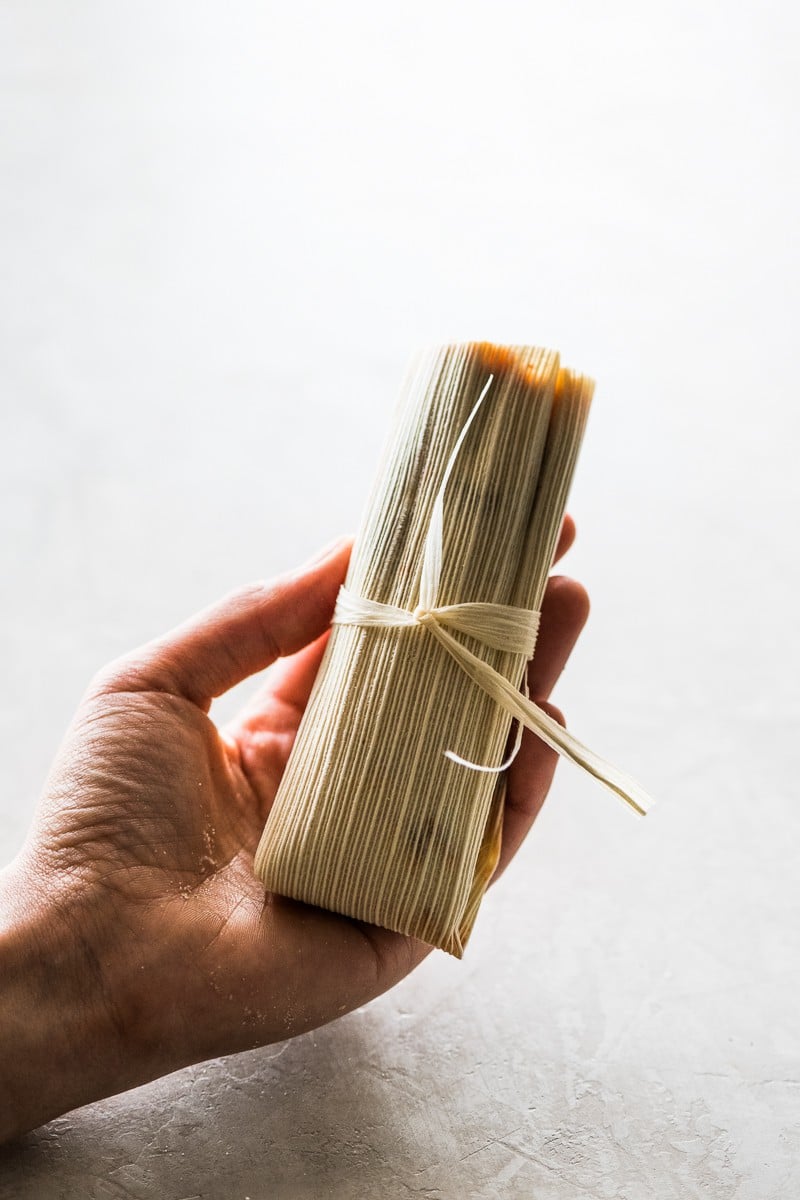
Ingredients
- Masa harina: This nixtamalized corn flour is needed to create the dough. It’s also the same kind that’s used to make corn tortillas and other Mexican staples. There are many brands of masa harina out there, and the most popular one is Maseca, which can be found in most large grocery stores nowadays. I also love using Masienda, which is produced in small batches directly from Mexico!
- Broth: To mix with the masa harina to create the dough. I used chicken broth for added flavor, but you could use beef broth, vegetable broth, or just plain water.
- Fat: Lard is what is traditionally used to make tamales (you could also use shortening), but my family always made them with vegetable oil like canola or avocado oil. I have instructions on how to make both variations in the recipe card below.
- Salt and baking powder: The salt flavors the dough and the baking powder helps to make it fluffy during the steaming process.
- Corn husks: You’ll need about 50 or so corn husks to spread out your masa and then fill it with the pork filling. You can find dried corn husks at most Mexican grocery stores or online.
- Meat: This version is made with pork shoulder (also known as ‘pork butt’), but you could also use beef if you prefer. If using beef, I recommend using beef chuck roast.
- Red chile sauce: You’ll need some guajillo chiles, ancho chiles, ground cumin, garlic powder, and salt. The meat is then cooked in this delicious sauce with a bay leaf until tender and melt-in-your-mouth!
How to Make Tamales
Prep the corn husks. Corn husks come dried, so you need to soak them in some hot water for an hour or so until they’re softened and easily foldable. Soaking them makes them easier to work with when it comes time for assembly.
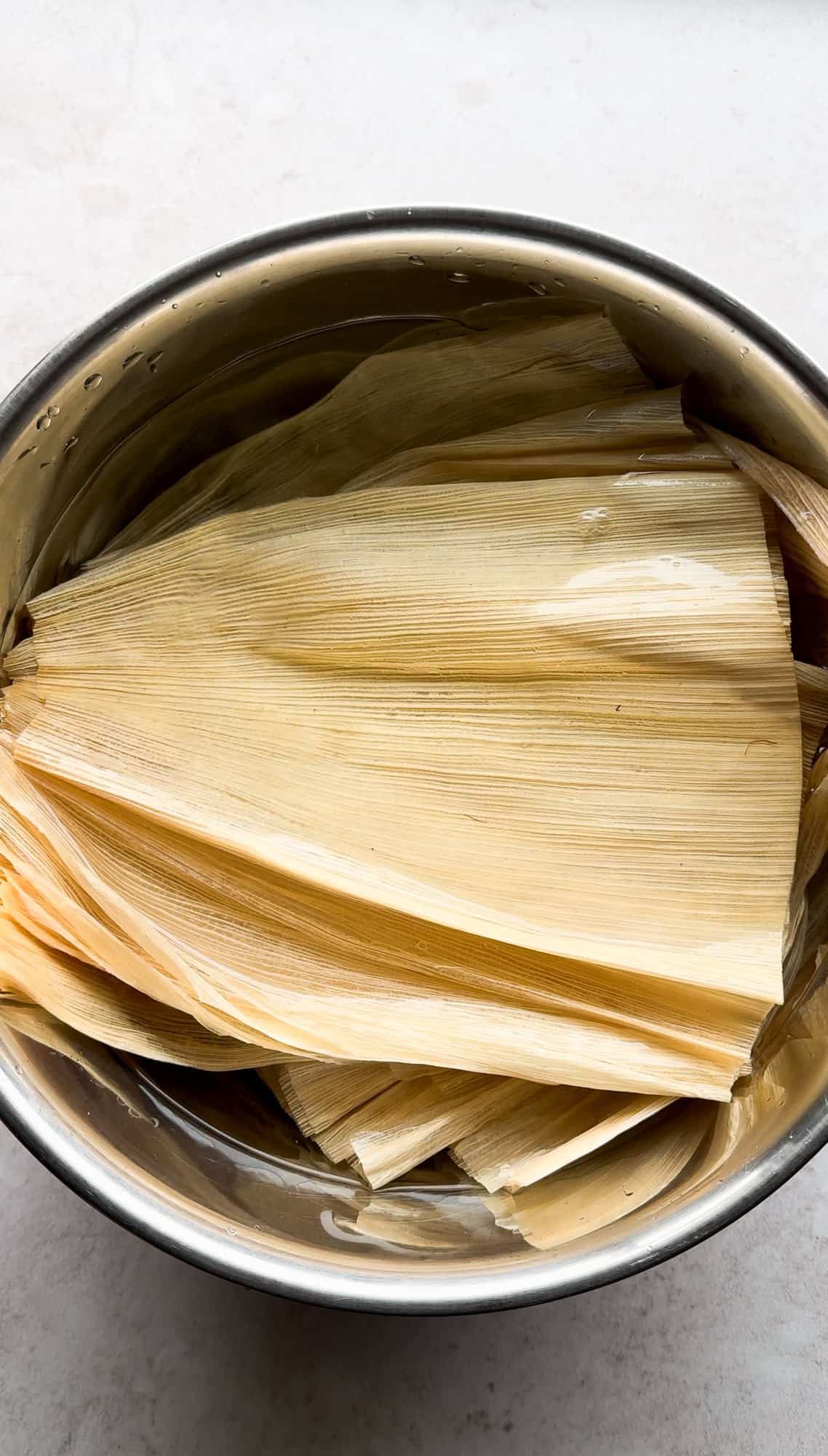
Make the red chile sauce. Rehydrate some guajillo and ancho chiles in hot water to soften them up before blending them with garlic powder, salt, and ground cumin.
This sauce isn’t very spicy, so if you’d like to add some heat, I recommend adding 3-5 árbol chiles. (This sauce mixture is very similar to my chile colorado.)
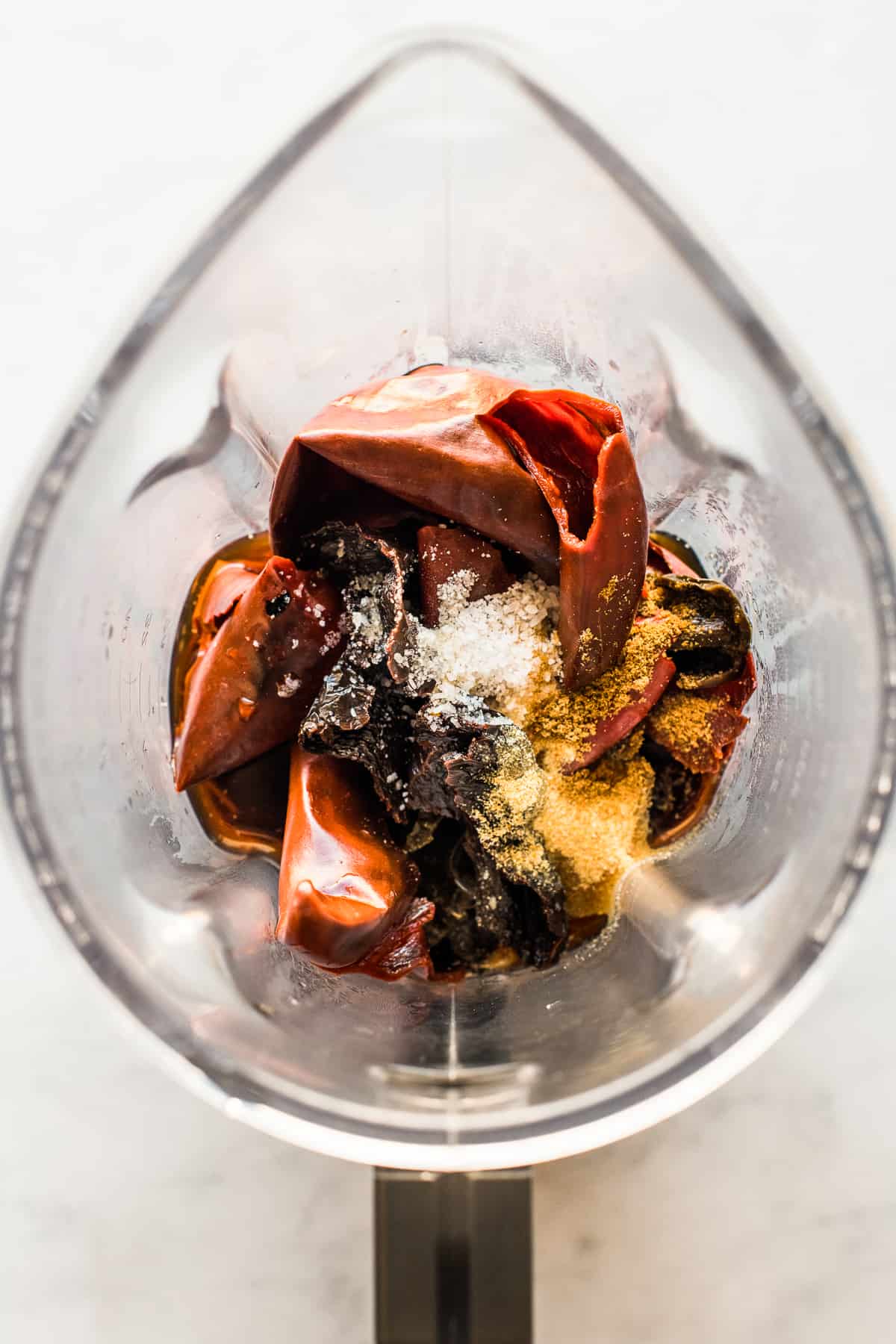
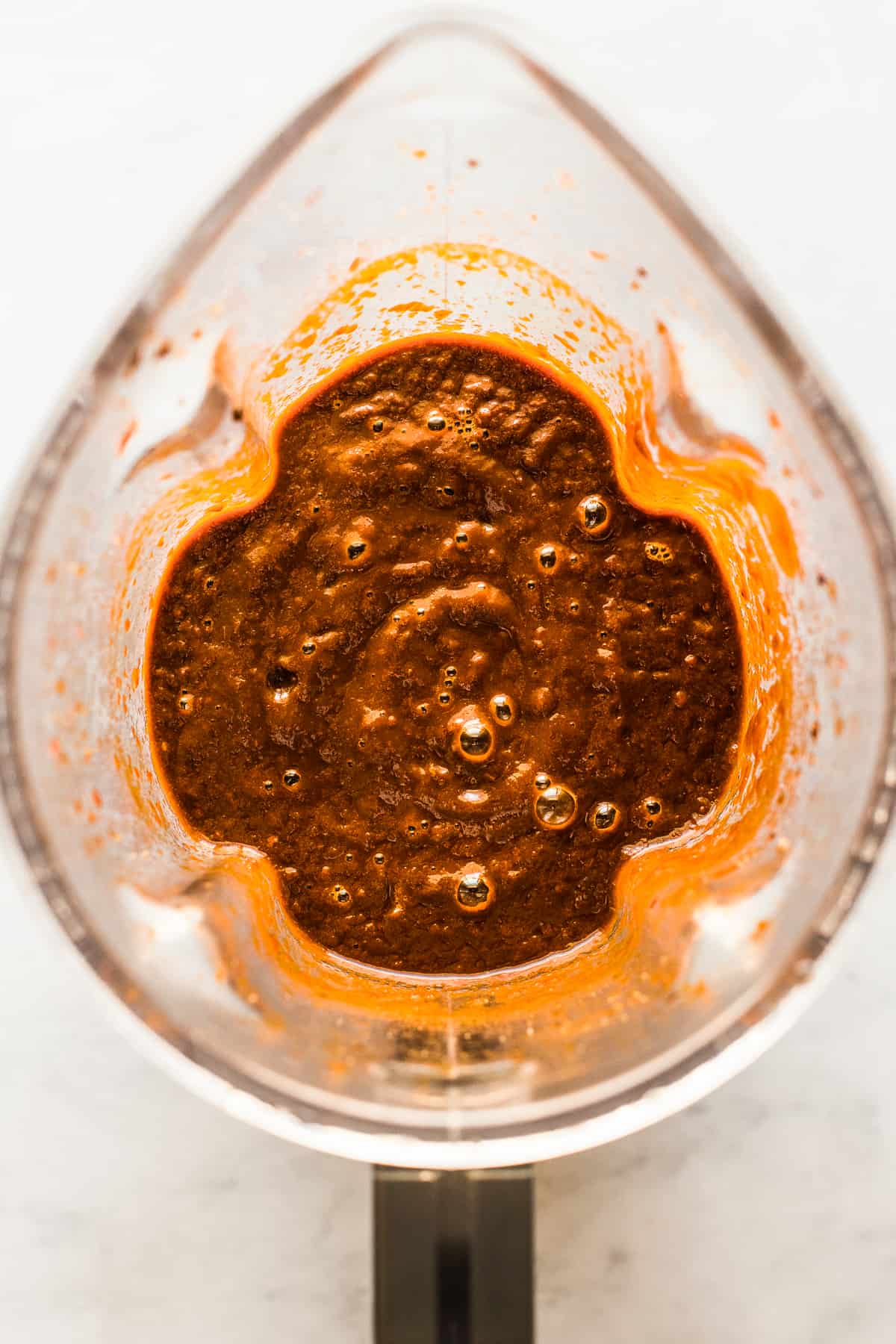
Cook the pork. Cut the pork into large 4-inch chunks and season it generously with kosher salt. Sear the pork on all sides in a large Dutch oven or pot, then pour in the blended chile sauce and cook it on the stove for 2 1/2 hours until the pork is fall-apart tender. It should shred very easily.
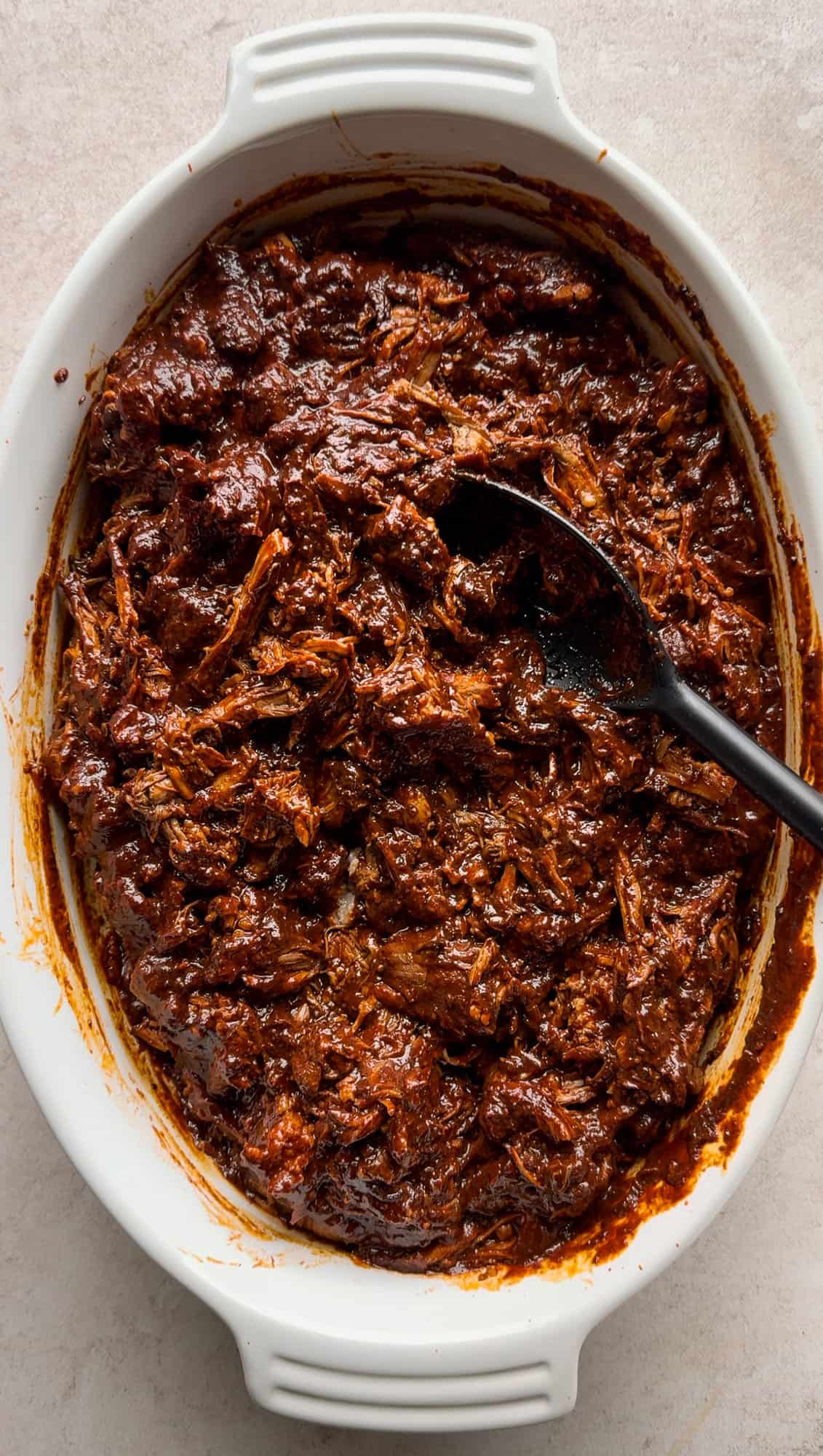
Make the masa. Mix together the masa harina and seasonings with the oil or lard and really work it into the dough with your hands or a stand mixer. I prefer using my hands so I can feel the texture of the masa while I’m mixing it.
Then add in the broth and mix once more until fully combined and fluffy.
- To make masa with oil, you’ll need 1 3/4 cups of vegetable oil (like canola or avocado) and 7 cups of broth or water.
- To make masa with lard, you’ll need 2 cups of lard and 8 cups of broth or water.
*Instructions for how to make both types of masa are included in the recipe card below.
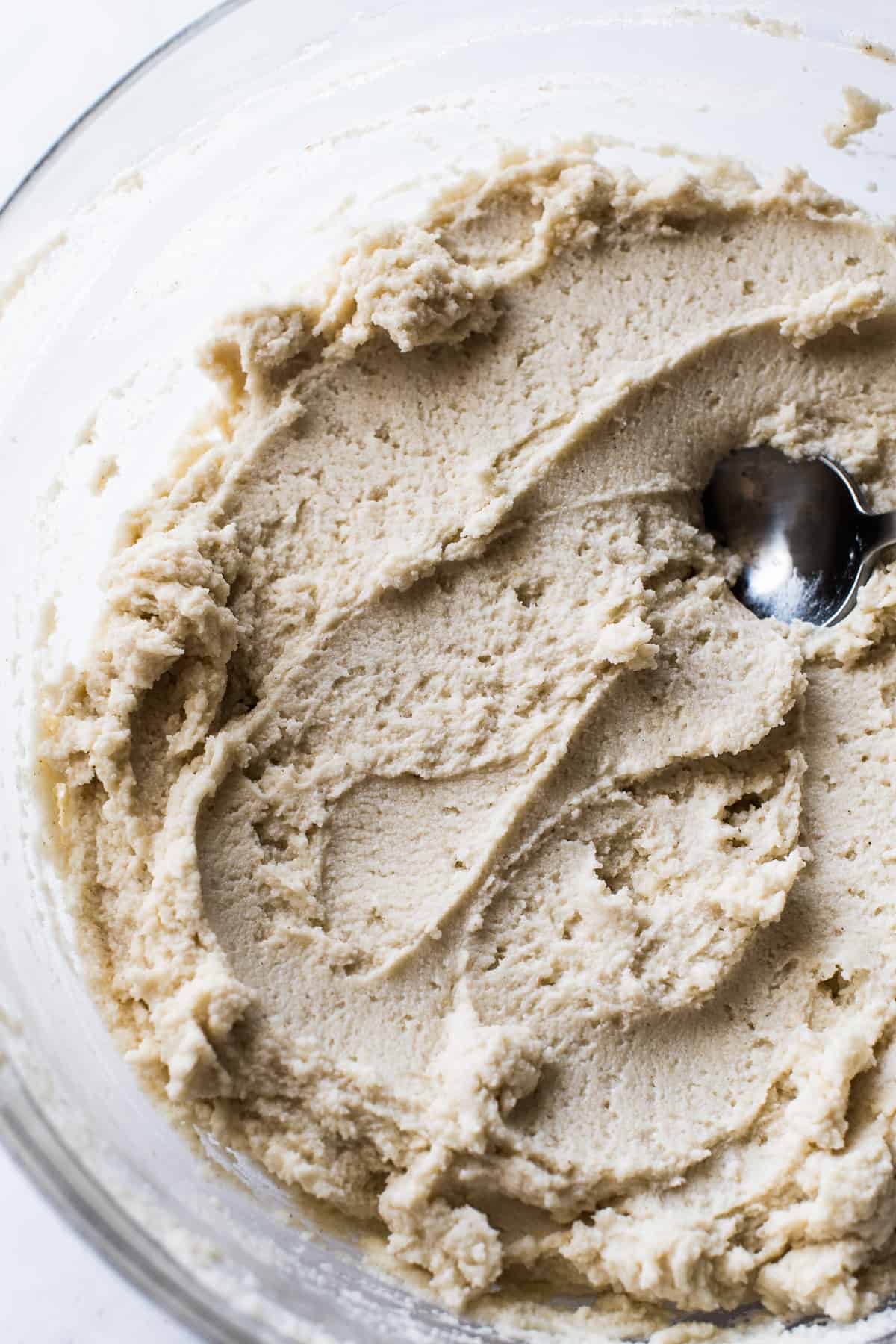
Dry the corn husks. Once you’re ready to start assembling, remove the corn husks from the soaking water and pat them dry with paper towels. Grab a husk that’s a fairly good size and sits comfortably in the palm of your hand.
The side of corn husk with a rough, ridged texture should face outward, while the relatively smooth and shinier side is where you’ll spread the masa.
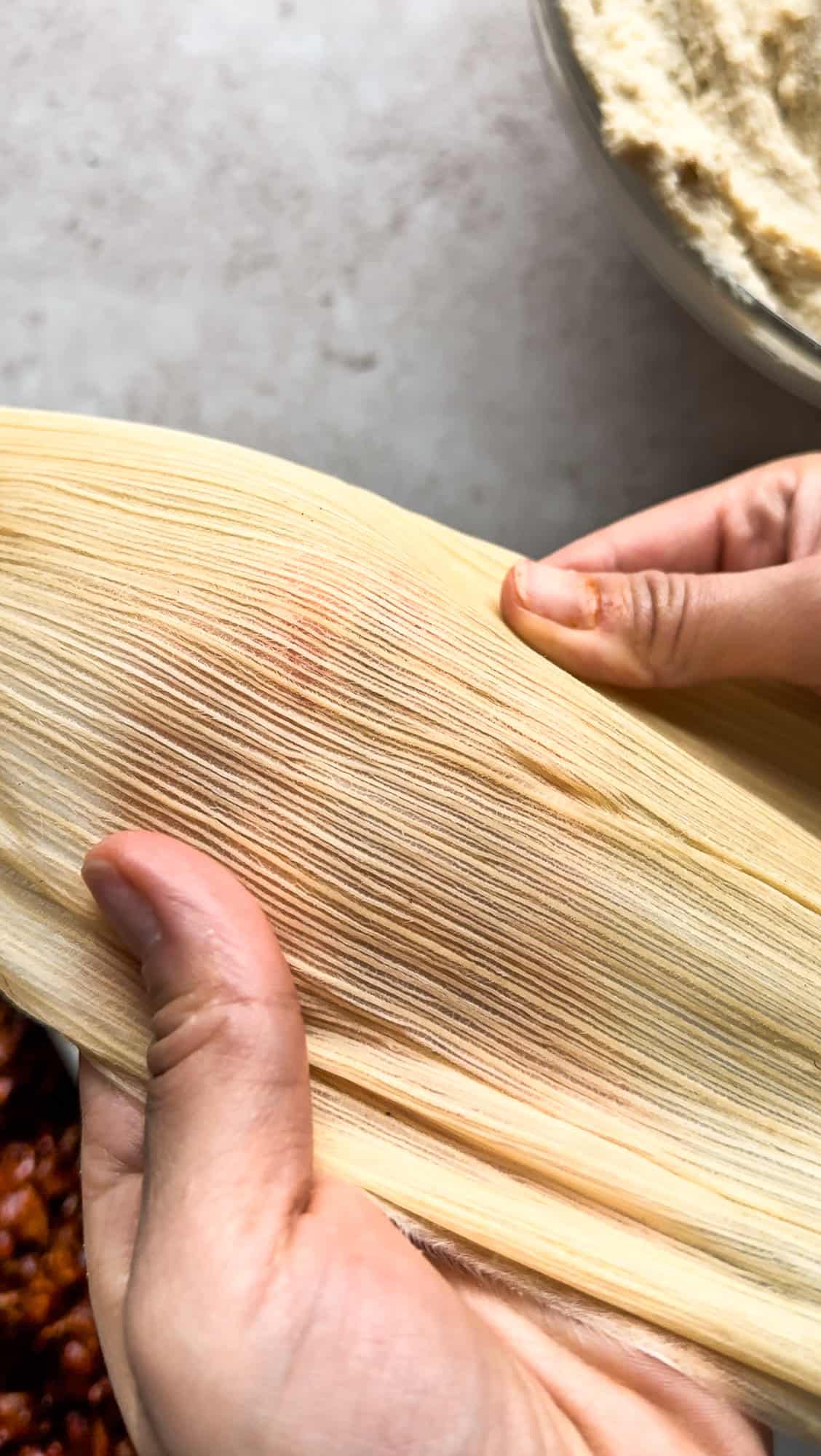
Spread the masa. Grab a heaping spoonful of masa and place it in the middle of the corn husk. Spread the masa onto the wide bottom half and a little bit of the top half using the back of your spoon as best you can.
You want to have a thin layer of masa on the corn husk, but not thin enough that it’s transparent and rips. If holding the corn husk and spreading the masa at the same time is too difficult, place the corn husk on a flat surface and spread.
Spreading the masa is sort of an art that can require a little practice, so just keep trying, and you’ll get better as you go!
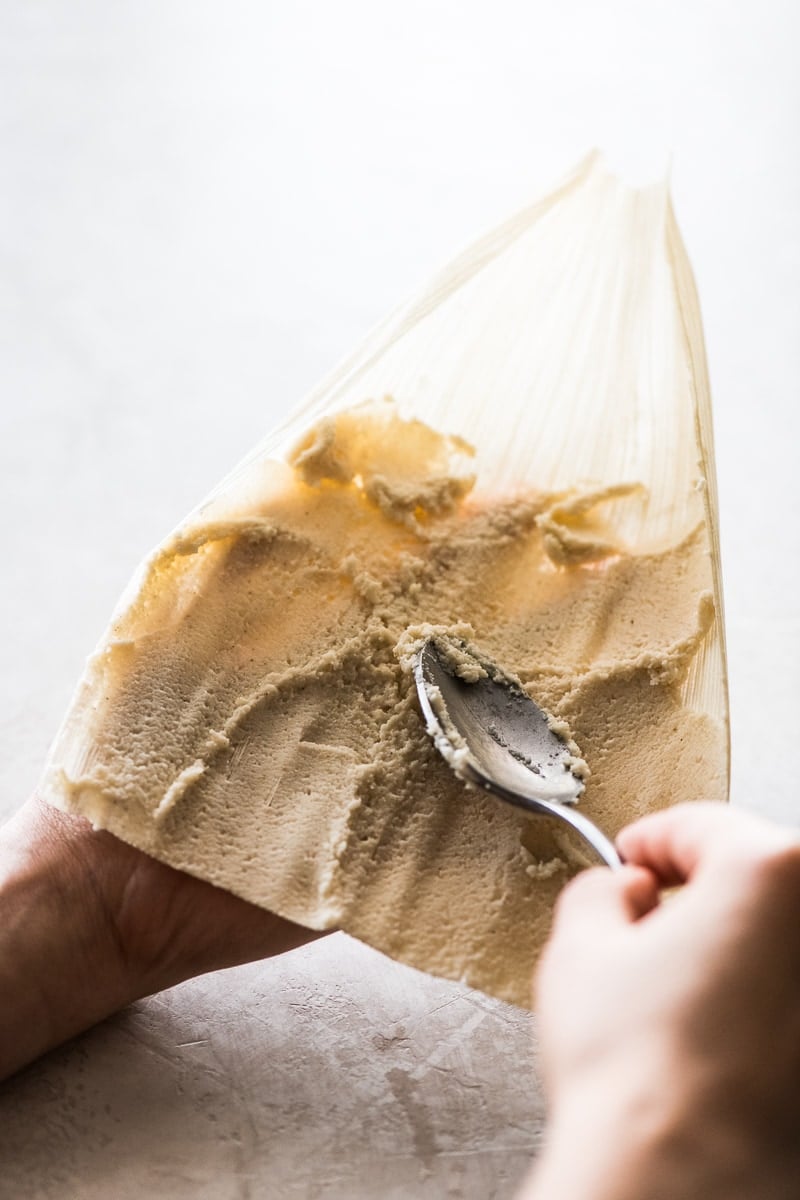
Fill. Place a spoonful of the filling in a line down the center of the dough. You only need a little bit, about 1-2 tablespoons. Try not to overstuff it, or the filling will ooze out when you fold it.
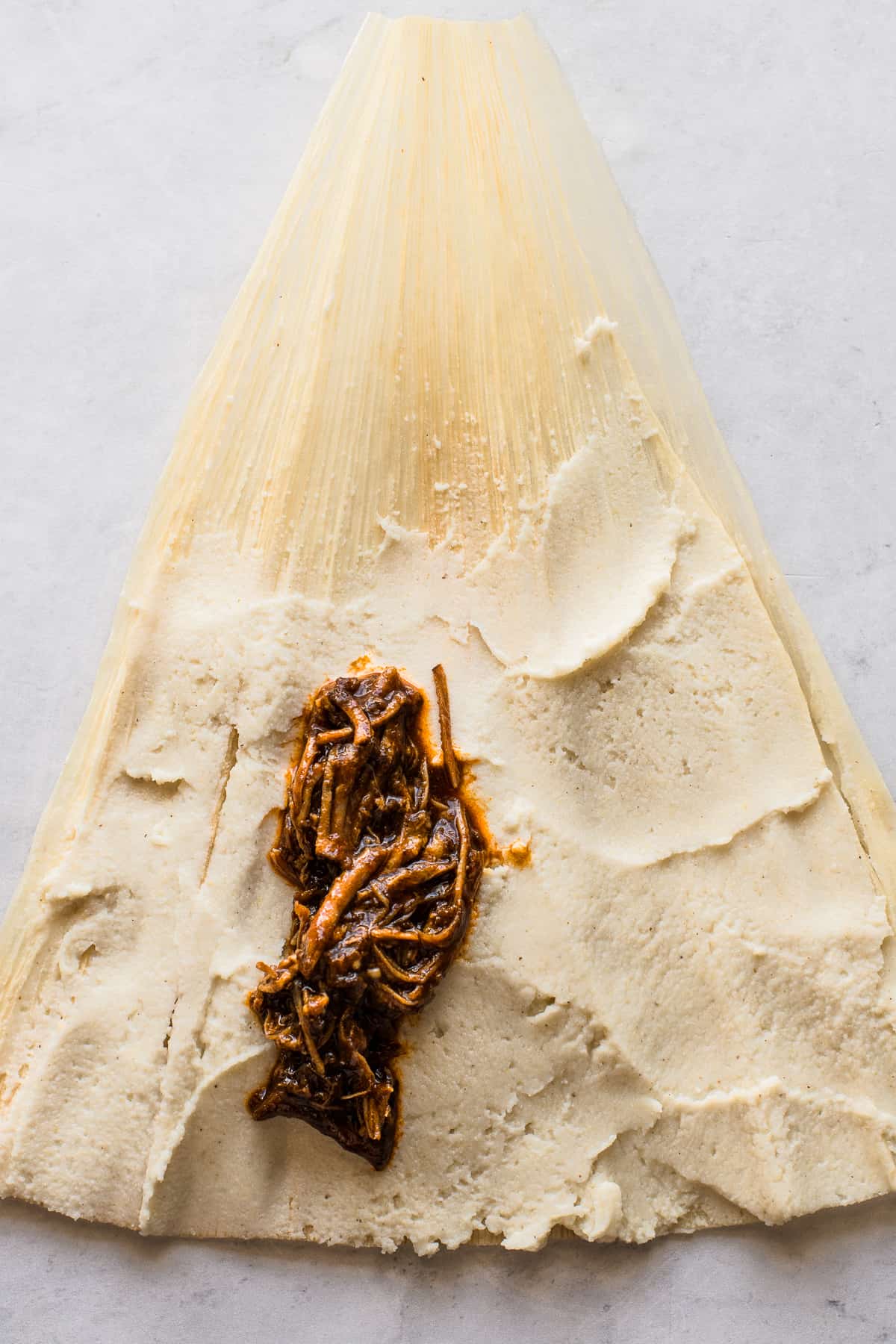
Fold. Fold the long edges of the corn husk together like a book, then again once more.
Fold the pointy edge of the husk up so that only one side of the corn husk is open. The tamales are cooked with the open side facing up, so the filling won’t fall out.
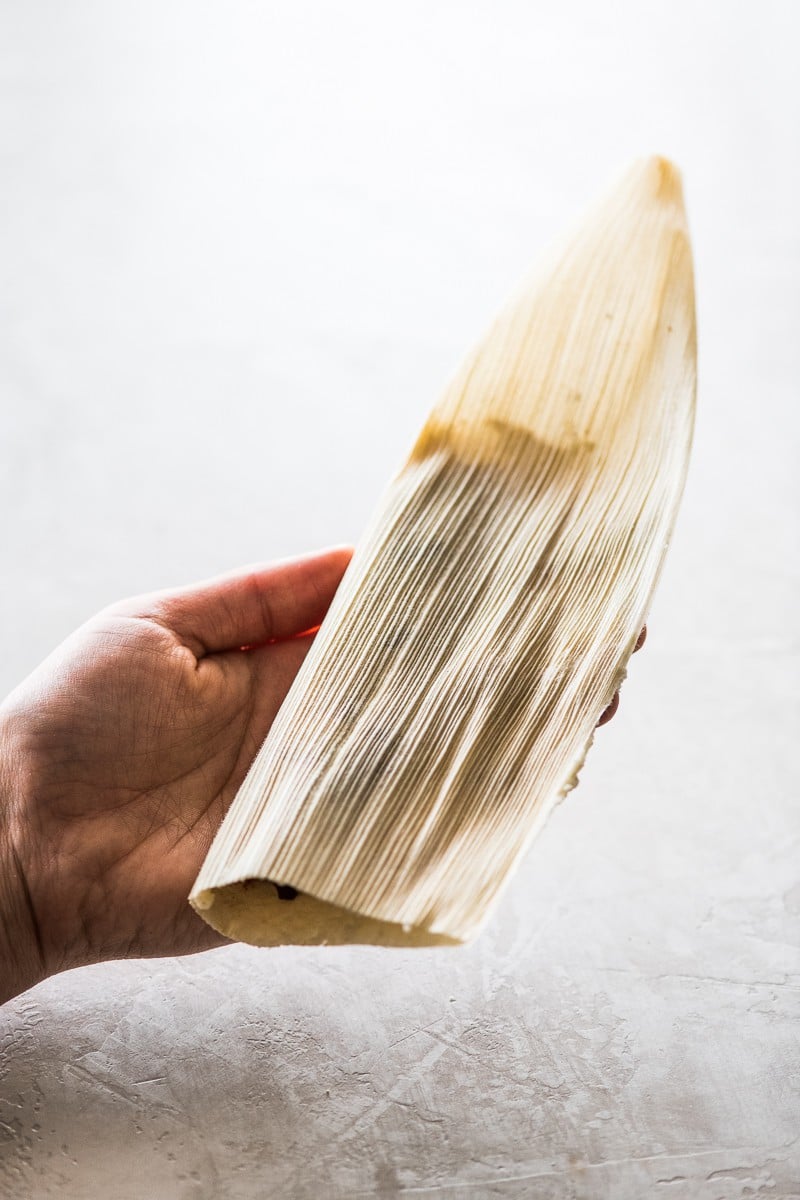
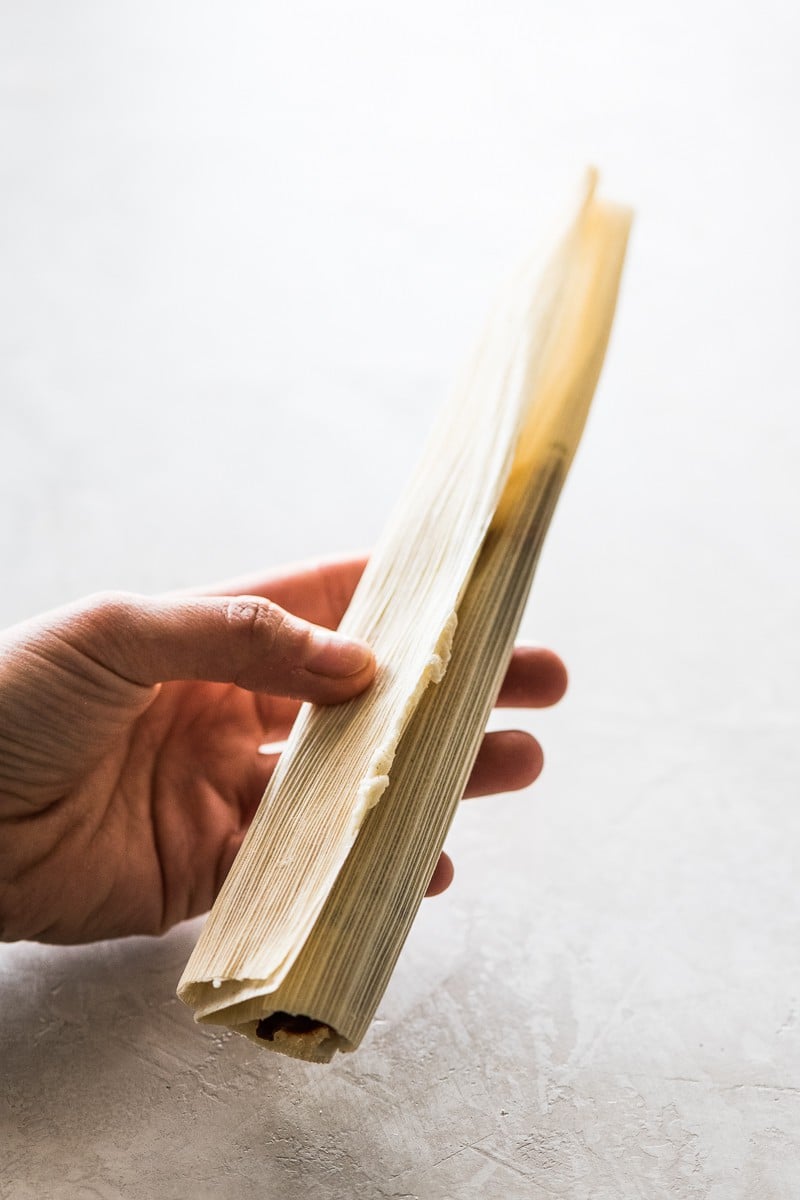
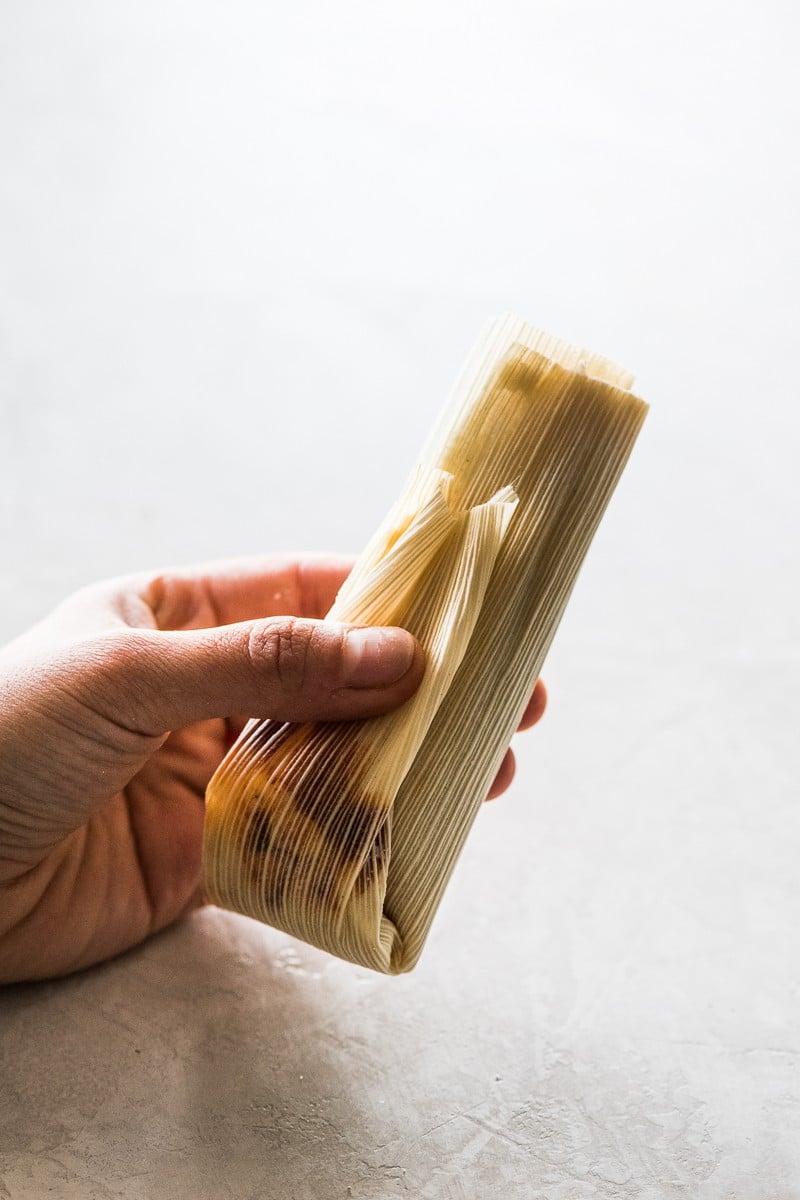
Cook: You’ll need a steamer pot to steam and cook the tamales once they’ve been filled and folded. If you have a large pot with a strainer, that will work. As long as the steamer insert sits above the water, that’s all you need.
- To steam, simply fill the bottom of the pot with water, insert the strainer, and then stand the tamales in the pot with the open side facing up. The last 10 or so tamales will be a tight fit, but squeeze them in as best as you can. Bring to a boil, reduce heat to simmer, and steam for 2 1/2 hours.
- To make in the Instant Pot, cook on high pressure for 45 minutes. Let the pressure release naturally for 15 minutes, then open the steam release valve to release any remaining pressure. Here’s a more detailed guide on how to make Instant Pot tamales.
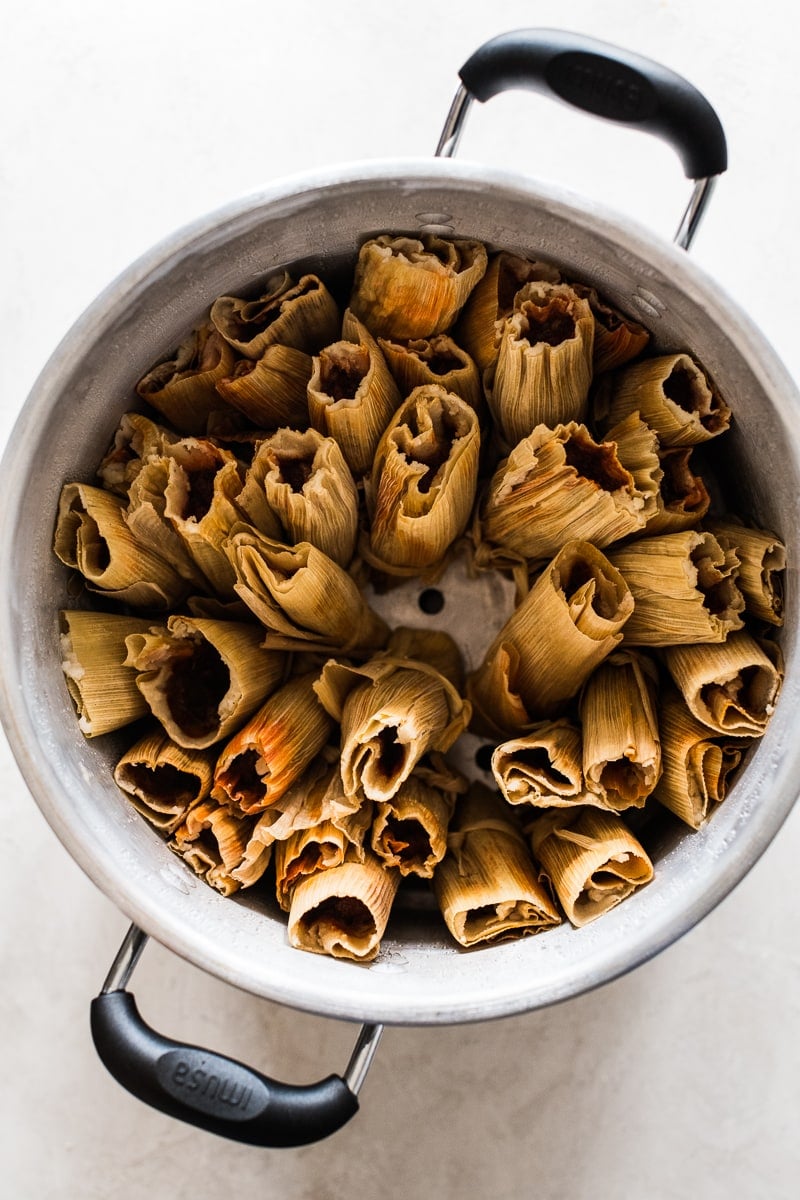
Helpful Tips
- Soak the corn husks. Before assembling the tamales, soak the corn husks in warm water for at least an hour. This makes them more pliable and less likely to tear during filling and folding.
- Spread the masa on the correct side of the corn husk. The side of the corn husk with a rough, ridged texture should face outward, while the relatively smooth side is where you’ll spread the masa. This makes the tamales easier to unwrap.
- Spread the masa evenly. When spreading the masa on the corn husks, aim for an even, thin layer. Too much masa can make the tamales doughy and heavy.
- Don’t overfill. While it’s tempting to add a lot of filling, overfilling can make the tamales burst open or leak during cooking. A small amount of filling is usually sufficient.
- Check for doneness. Tamales are done when the husk peels away from the masa easily. For tamales made with lard, this usually takes about 1 to 1.5 hours of steaming. For tamales made with oil, this usually takes about 2.5 hours of steaming. Time may vary depending on the amount of tamales you make.
- Let them rest. After cooking, let the tamales rest for 10 minutes on a serving tray or baking sheet. This helps them firm up and makes them easier to unwrap.
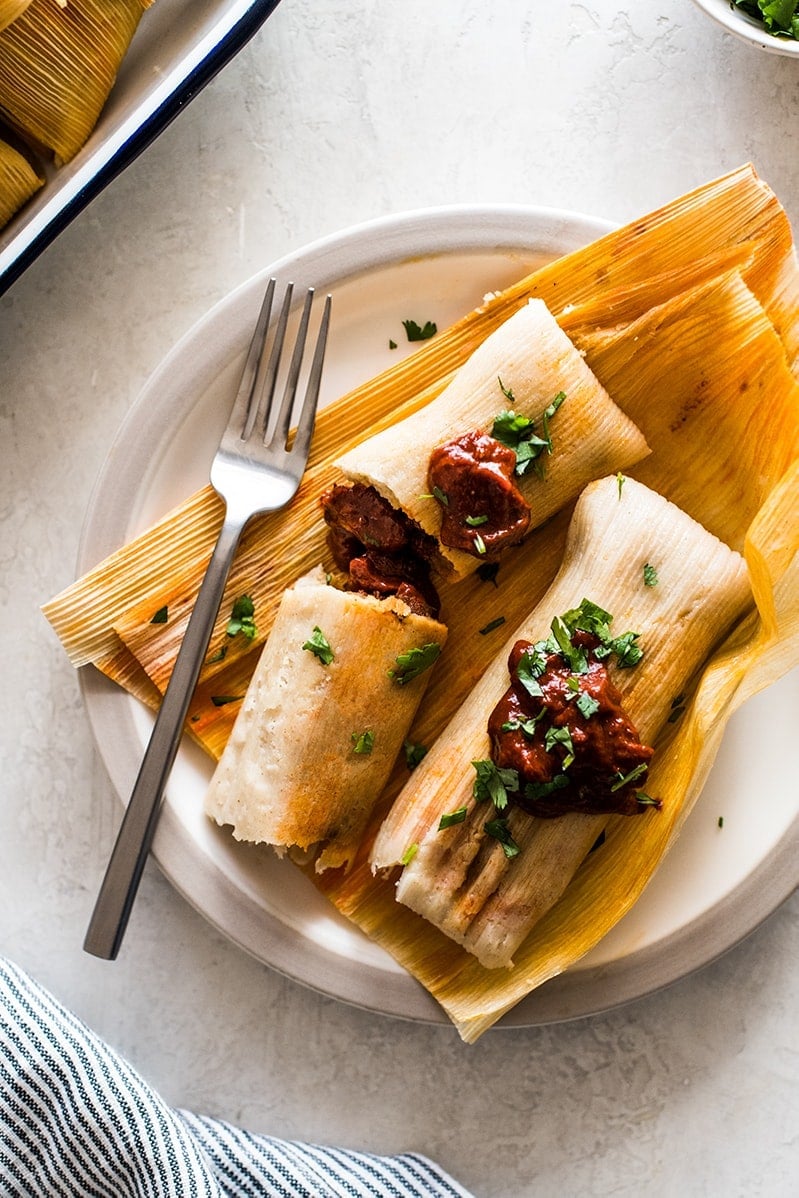
Recommended Tools
- Steamer pot. This 16-quart pot is the perfect size to fit the amount of tamales made in this recipe (about 45-50). I actually have two of these pots since my family always makes larger batches!
- Stand mixer. Using a stand mixer to make masa can be easier than mixing by hand, especially for the lard version.
- Large mixing bowls. These are great for setting out and organizing all of your prepped ingredients so that the assembly process goes smoothly.
Make Ahead
The red chile pork and masa dough can be made up to 3 days in advance.
Store them separately in an airtight container in the fridge until ready to use.
Storing, Freezing, and Reheating
Tamales can be stored in an airtight container in the refrigerator for up to one week or in the freezer for up to 6 months.
They can be reheated using 3 different methods:
- Steamer: Steam them for 15 minutes in a steamer pot.
- Oven: Heat them in a 350°F oven for 15 minutes.
- Microwave: Cover them with a damp paper towel and microwave them in batches for 1-2 minutes on high.
More Mexican Recipes
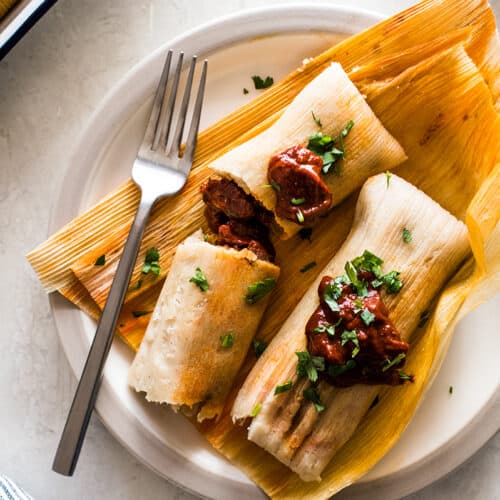
Mexican Tamales
Video
Ingredients
For the filling
- 3 ounces guajillo chiles, rinsed, stemmed, and seeded
- 3 ounces ancho chiles, rinsed, stemmed, and seeded
- Water, as needed
- 1 ½ teaspoons garlic powder
- 3 teaspoons kosher salt, divided
- ¾ teaspoon ground cumin
- 2 tablespoons olive oil
- 2 ½ pounds boneless pork shoulder, cut into large 4-inch chunks
- 1 bay leaf
For the masa dough
- 8 ¼ cups masa harina (about half of a 4.4 lb bag of Maseca)
- 1 ¾ tablespoons fine salt
- 1 tablespoon baking powder
- 1 ¾ cups canola or avocado oil (see Notes for making masa with lard*)
- 7 cups broth (chicken, beef, or vegetable, plus more as needed)
- 50 corn husks (about ½-¾ pound bag)
- Hot water, as needed
Instructions
- Prep the corn husks. Add the corn husks to a large bowl or pot. Pour enough hot water over the corn husks to cover them completely. Cover the bowl with foil or plastic wrap and let them soak for 1 hour to soften them up. Meanwhile, make the filling and masa dough.
- Make the chile sauce. Add the guajillo chiles, chiles, and enough water to completely cover them in a medium pot. Bring to a boil over high heat. Remove the pot from the heat, cover, and let the chiles soak for 10 minutes to soften.
- Using a slotted spoon, transfer the softened chiles to a large blender. Add 1 cup of the chile-soaked water, 1 ½ cups of fresh water, garlic powder, 1 ½ teaspoons kosher salt, and ground cumin. Blend until completely smooth. If the sauce is not smooth, pour it through a fine mesh strainer into a bowl to remove any solids.
- Cook the pork. Heat the oil in a large Dutch oven or pot over medium-high heat. Season the pork with the remaining 1 ½ teaspoons of kosher salt, then working in 2 batches, add the meat and sear on all sides until browned.
- Add all the seared meat back to the pot. Carefully pour in the blended red chile sauce and stir in the bay leaf. Bring to a boil, reduce the heat to low, cover, and simmer for 2 ½ hours until the meat is fall-apart tender.
- Make the masa dough. (See Notes for how to make masa with lard.) In a very large mixing bowl or pot, add the masa harina, salt, and baking powder. Stir together to combine.
- Add the oil and mix it together using your hands. Work the dough through your fingers until everything is well combined and incorporated. The dough should feel a little crumbly, almost like wet sand, and should lightly hold its shape when pressed together.
- Add the broth and mix for about 3-5 minutes until the dough is fairly wet and well-saturated. The dough should be soft and spreadable like thick hummus. If the dough is too dry, add more broth. If it’s too wet, add more masa harina.
- Finish prepping the corn husks. Drain the water from the corn husks and pat them dry. Lay them flat onto a baking sheet for easy access.
- Spread the masa onto corn husks. Grab a corn husk and identify which is the smooth side and which is the side with ridges. Place the smooth side face up onto the palm of your hand or on a plate. Grab a heaping spoonful of masa and place it in the middle of the corn husk. Spread it in a thin layer using the back of the spoon to create a large square shape, leaving the top ⅓ of the corn husk empty. (See post above for step-by-step photos)
- Add the filling. Place a spoonful of the filling in a line down the center of the dough. You only need a little bit, about 1-2 tablespoons. Try not to overstuff it, or the filling will ooze out when you fold it.
- Fold. Fold together the long edges of the corn husk like a book, and then fold it once more. Fold the pointy edge up so that only one side of the corn husk is open and exposed. Set aside and continue assembling all of the tamales until you’ve used up all the dough.
- Prepare the steamer pot. Fill the bottom of a large steamer pot with water. Add a penny or coin to the bottom of the pot, then cover with the steamer insert. Place the tamales in the steamer pot with the open end facing up. Lean them against the side of the pot so they don't fall down.
- Steam. Cover tightly with the lid and place the steamer over high heat. Bring the water to a boil. You’ll know it’s boiling when you hear the coin rattle in the pot! Reduce the heat to medium-low and cook for 2 ½ hours or until the masa is fully cooked. (See notes on cooking time if making masa with lard.)
- Check for doneness. Remove 1 tamal from the steamer pot. Let it sit for 10 minutes. If the husk peels away easily from the masa, then it’s done. If the masa is still gooey or sticks to the husk, steam it for 15 more minutes, then check again.
- Serve. Remove the tamales from the pot and let them cool for 10 minutes before serving to help them firm up and make them easier to unwrap.
Notes
- Yields: The recipe makes 45-50 tamales and fits in a 16-quart steamer pot or larger. It’s a bit of a squeeze, but they fit.
- To make the masa using lard: You’ll need 2 cups lard, 8 ¾ cups masa harina, 1 ¾ tablespoons fine salt, 1 tablespoon baking powder, and 8 cups of broth. In a large bowl, beat the lard for 1 minute using an electric handheld mixer or a stand mixer until whipped and fluffy. In a separate bowl, combine the masa harina, salt, and baking powder. Add it to the bowl with the lard and mix together to combine. While mixing, slowly add in the broth. Continue to mix until the dough is smooth, fluffy, and has the texture of thick hummus.
- Cooking time for tamales made with lard: 90 minutes.
- Make ahead: The red chile pork and masa can be made up to 3 days in advance. Store it in an airtight container in the fridge until ready to use.
Nutrition Information
This post was first published in December 2019 and was updated in December 2023 with clearer instructions, a slightly updated recipe, and more helpful tips.
Making a Large Batch
Tamales are typically made in large batches for celebrations, holidays and special occasions in Mexican culture. When my family and I make tamales, we usually double the above recipe. Here are those ingredient amounts for your convenience:
Amount for double the recipe (about 100 tamales)
For the filling
- 6 ounces dried guajillo chiles
- 6 ounces dried ancho chiles
- Water, as needed
- 1 tablespoon garlic powder
- 1 tablespoon kosher salt, plus more as needed
- 1 1/2 teaspoons ground cumin
- 5 pounds pork shoulder, excess fat removed and cut into large 4-inch chunks
- 3 tablespoons vegetable oil
- 1 bay leaf
For the masa dough
- 16 1/2 cups masa harina (a whole 4.4 lb bag Maseca)
- 3 1/2 tablespoons fine salt
- 2 tablespoon baking powder
- 3 1/2 cups canola oil
- 13 cups broth

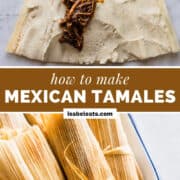

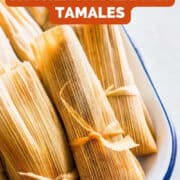



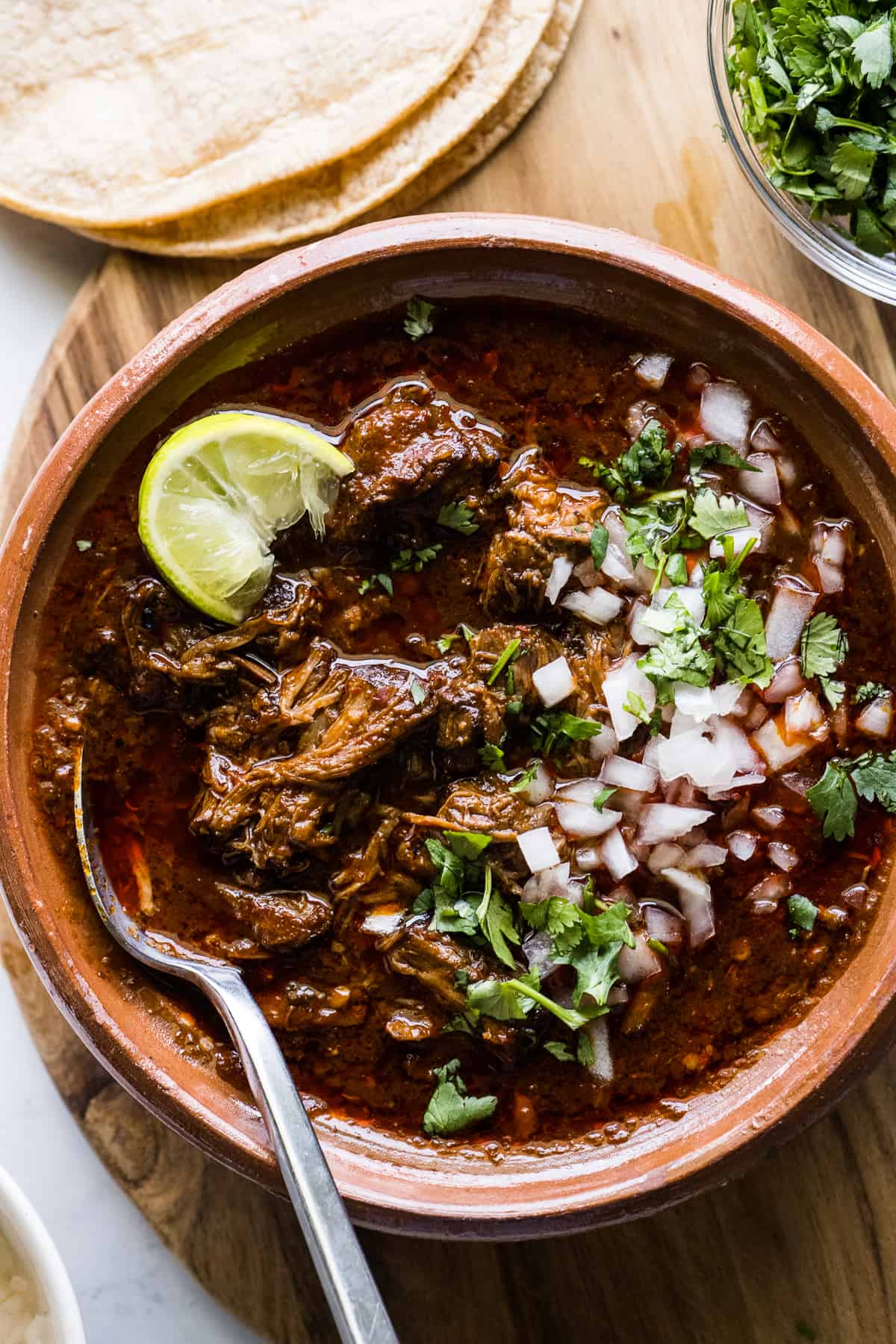
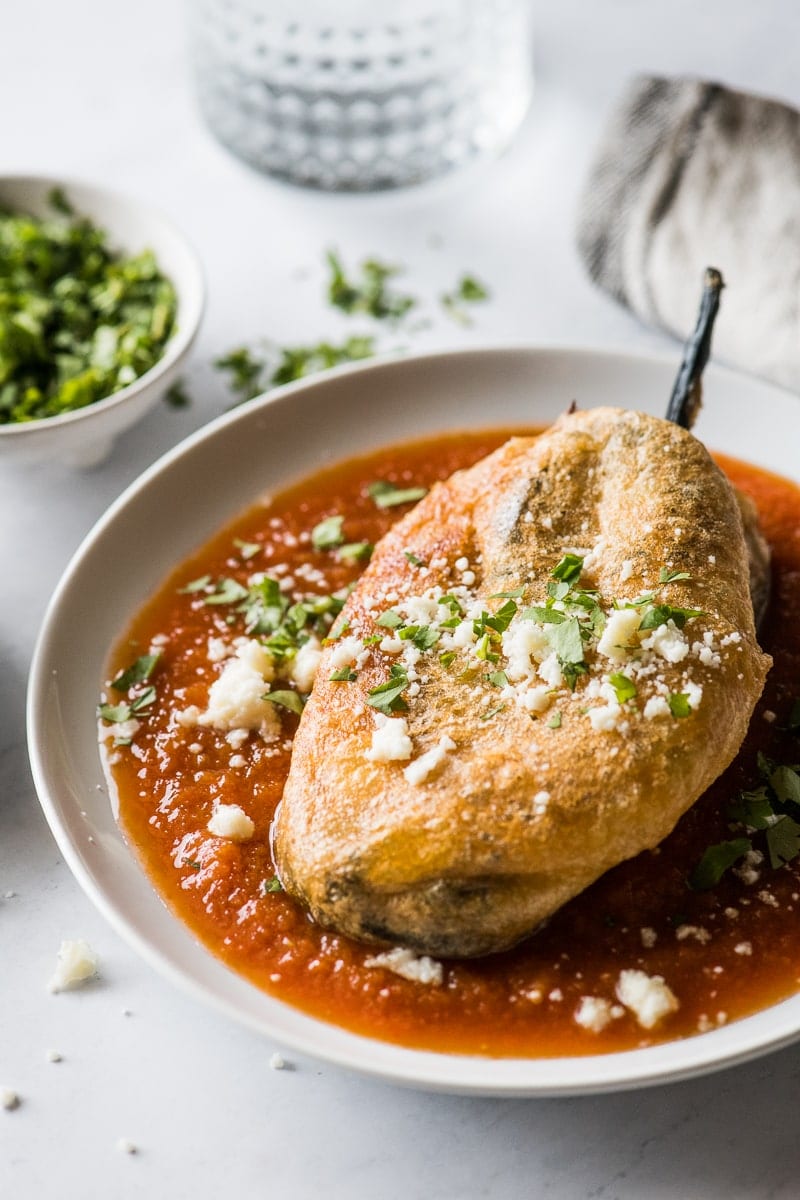
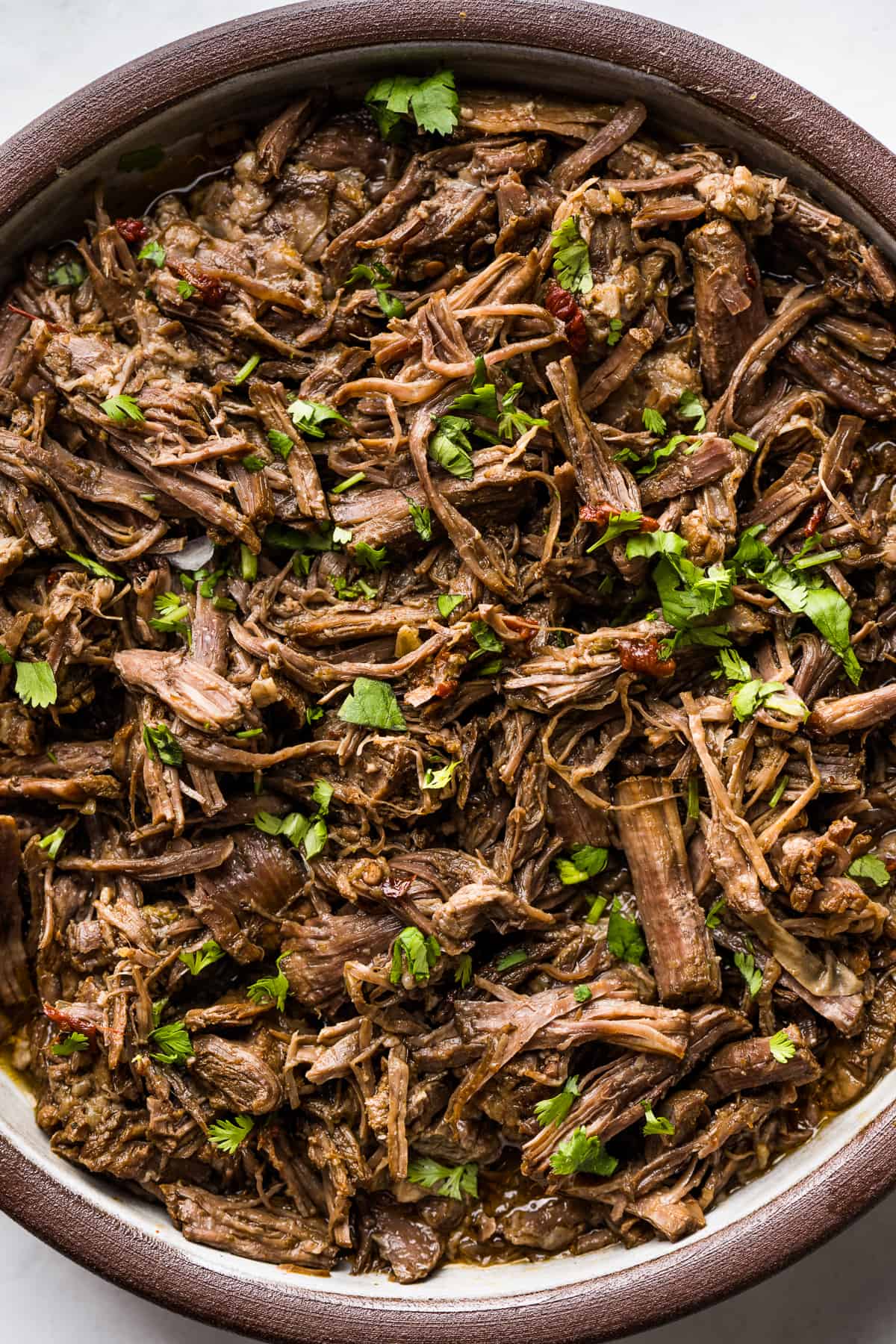
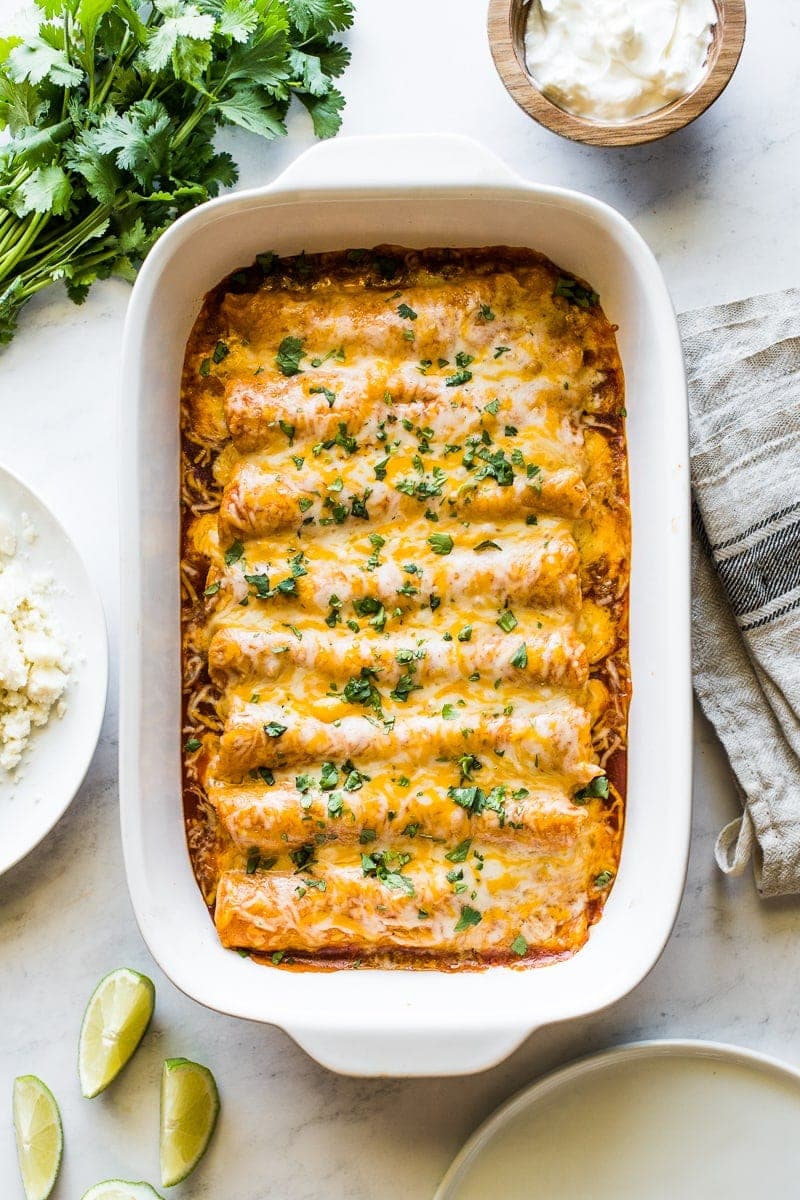
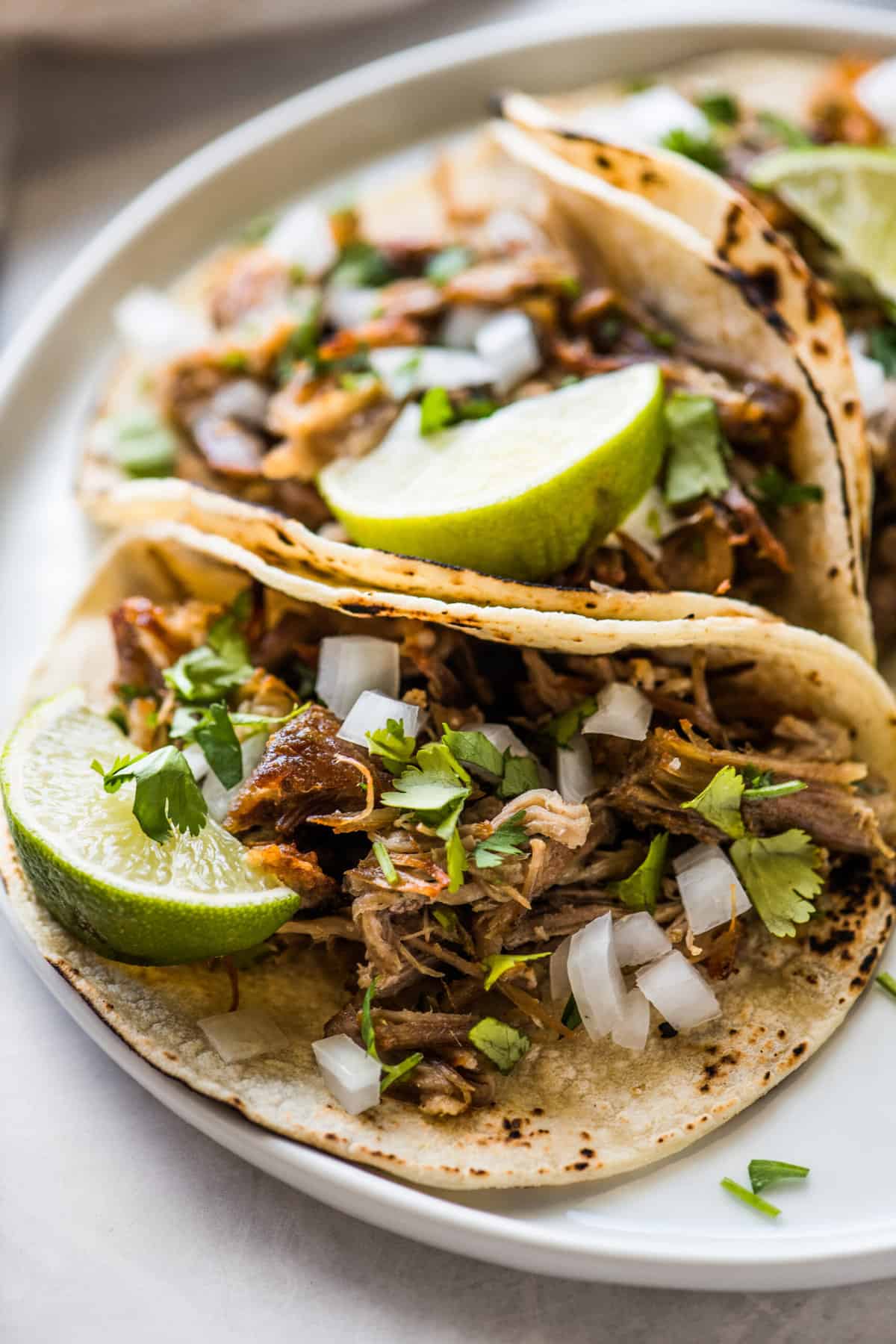
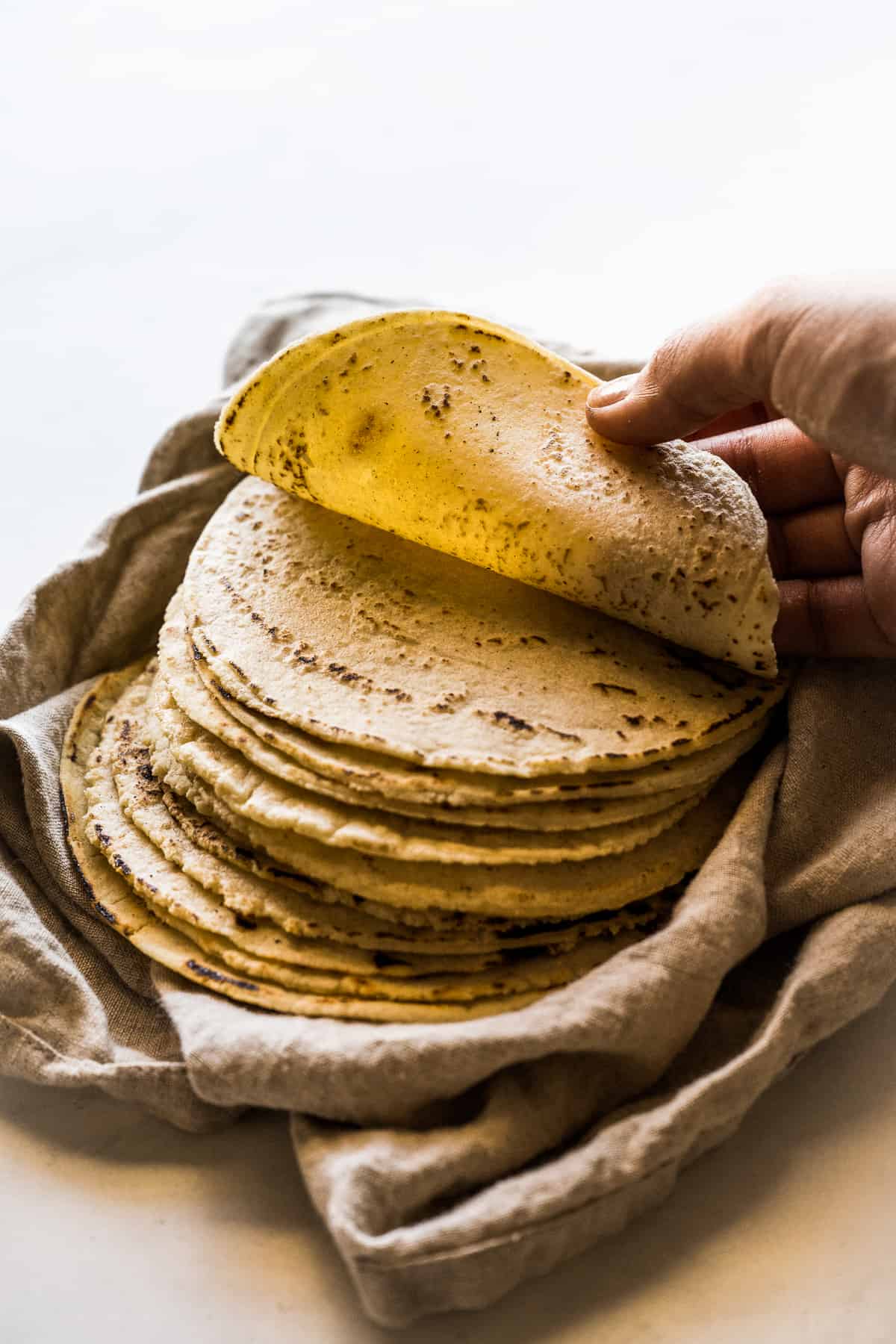
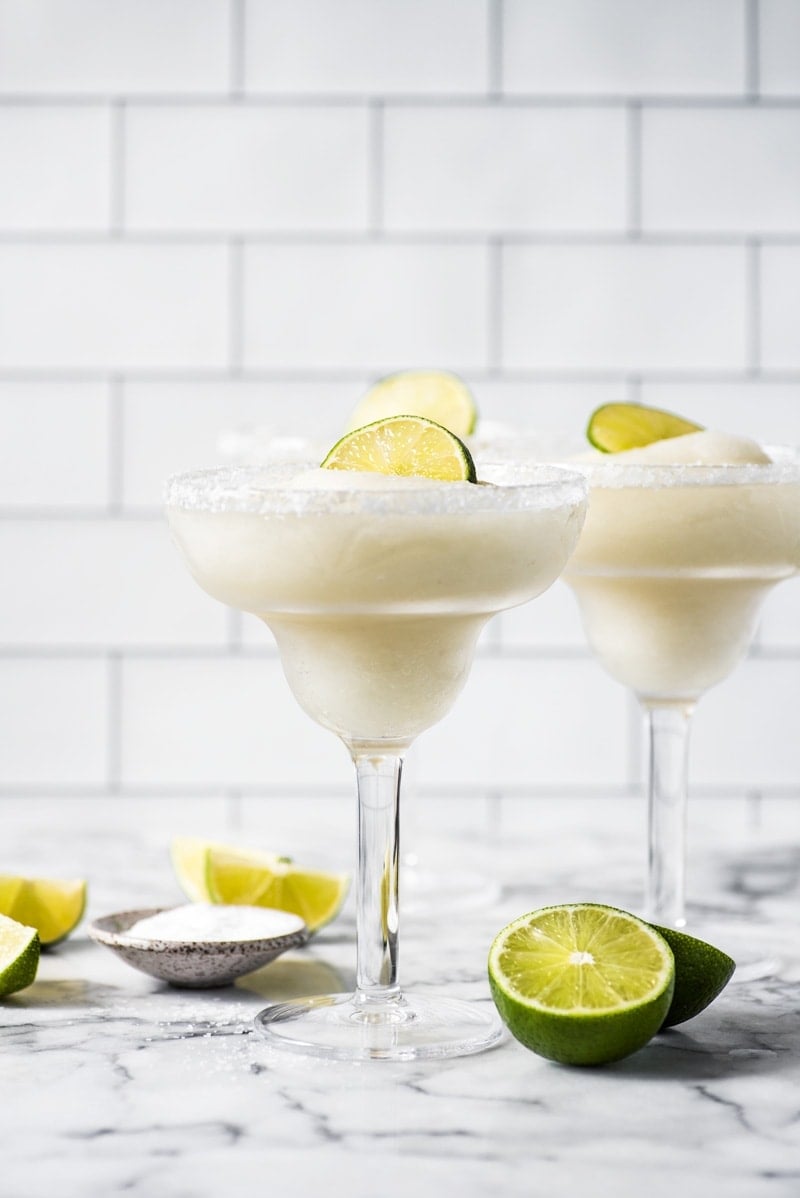

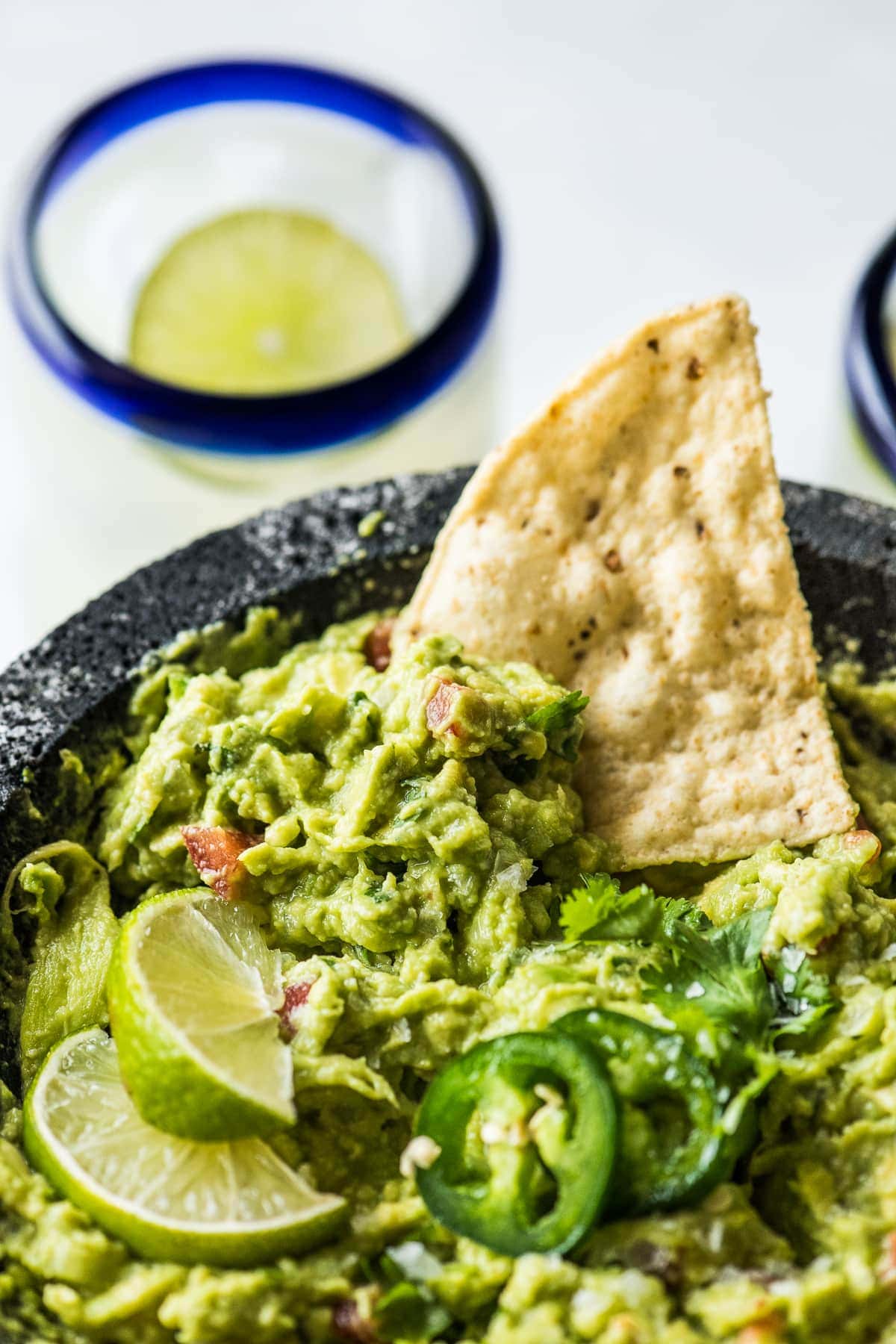
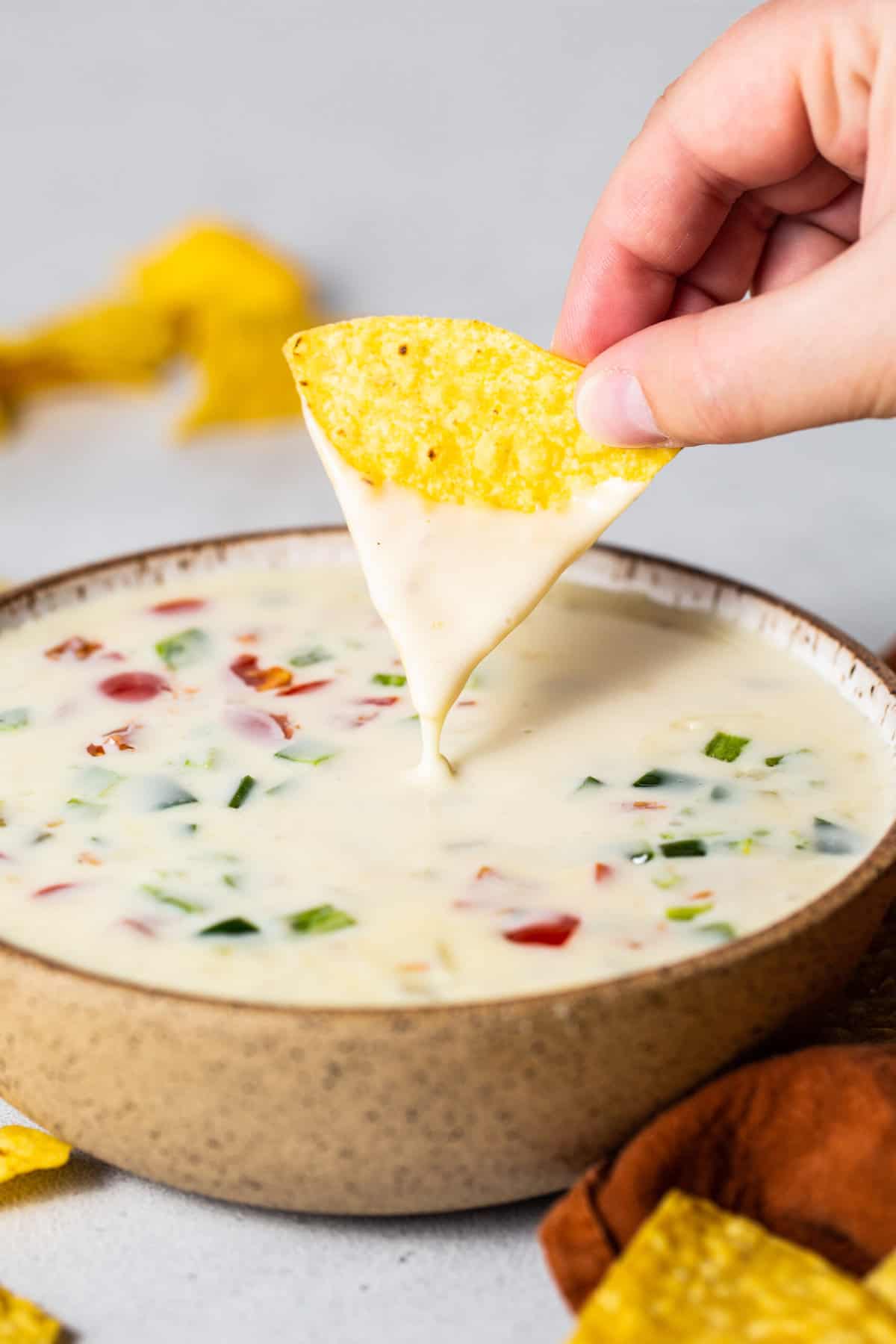
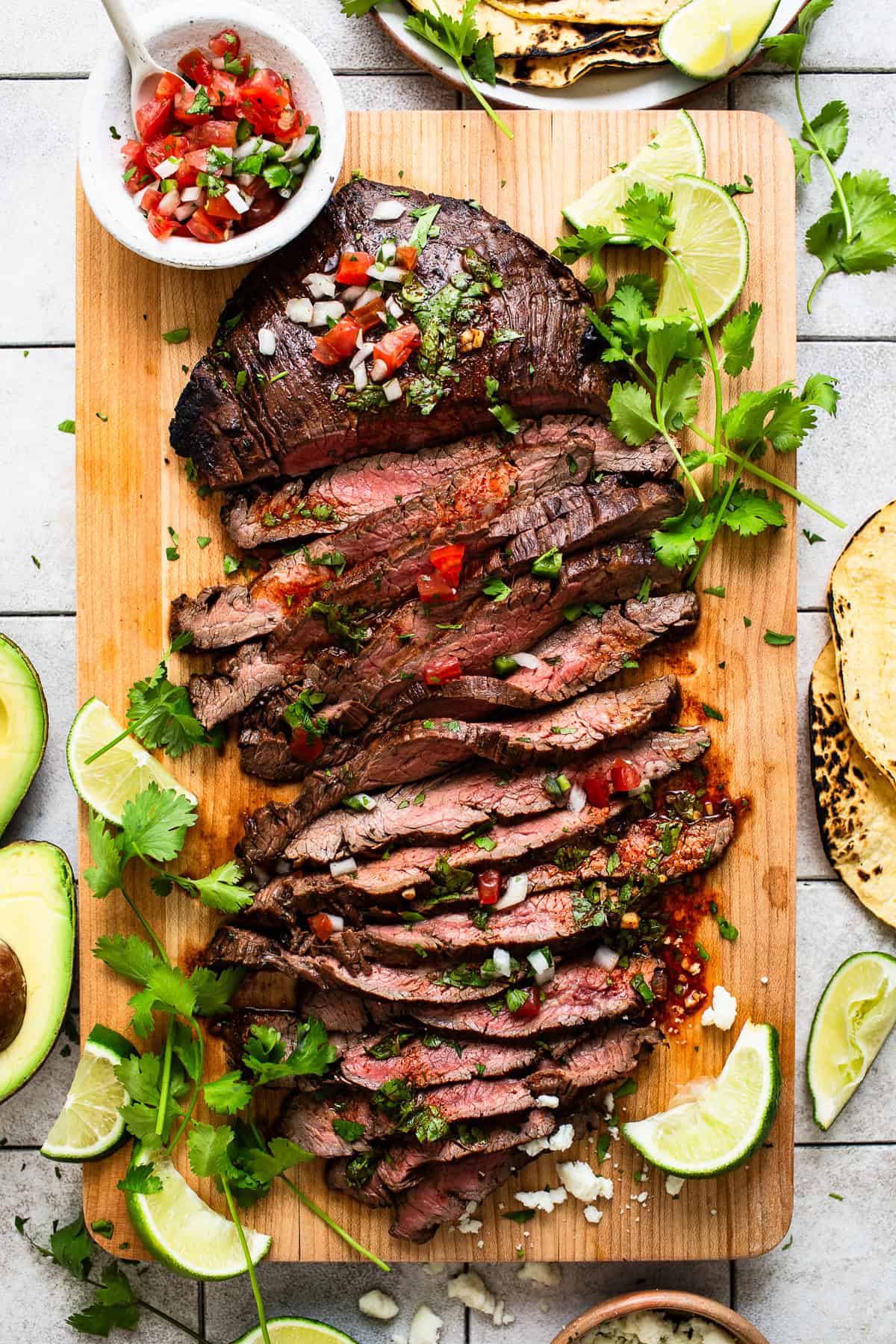
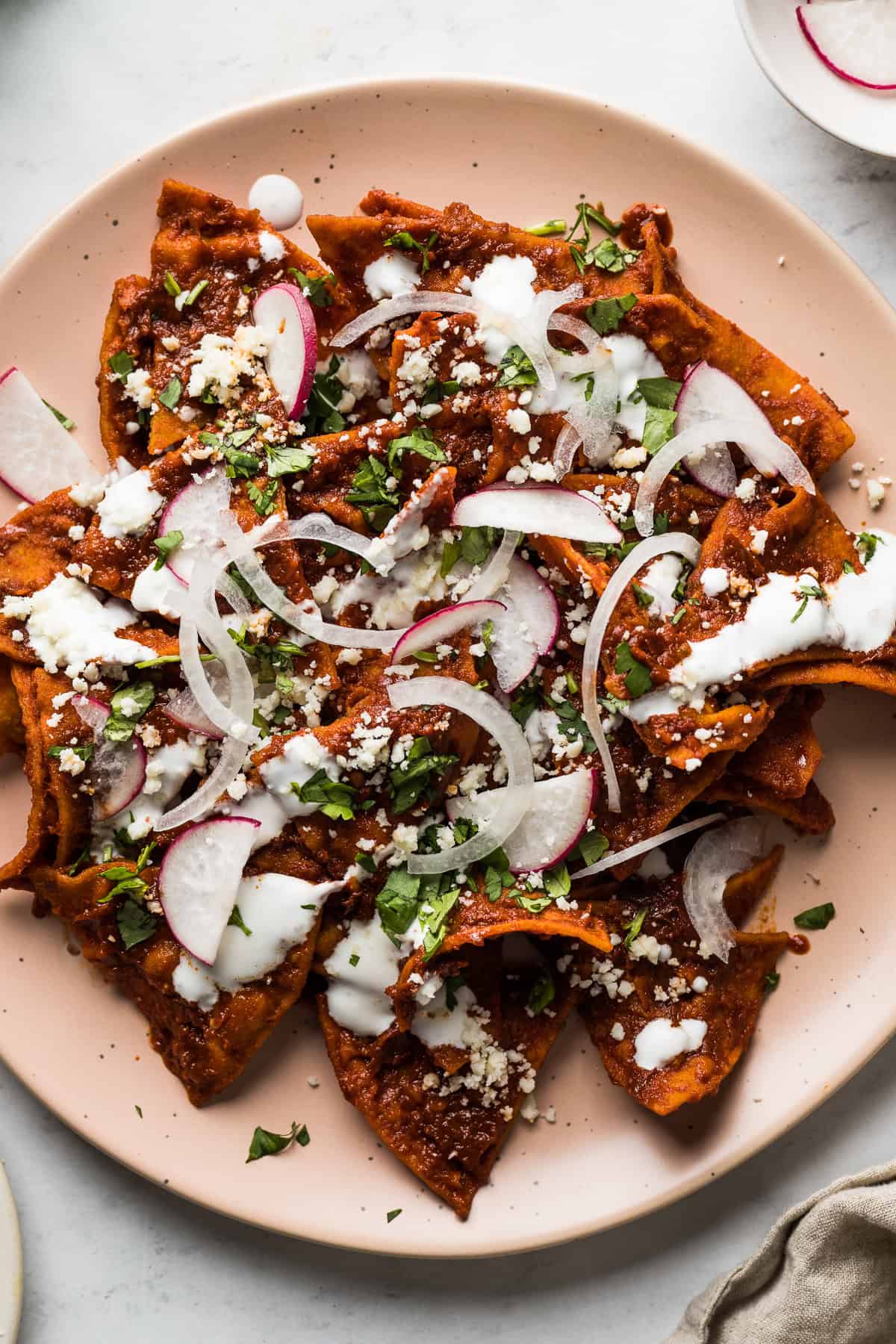
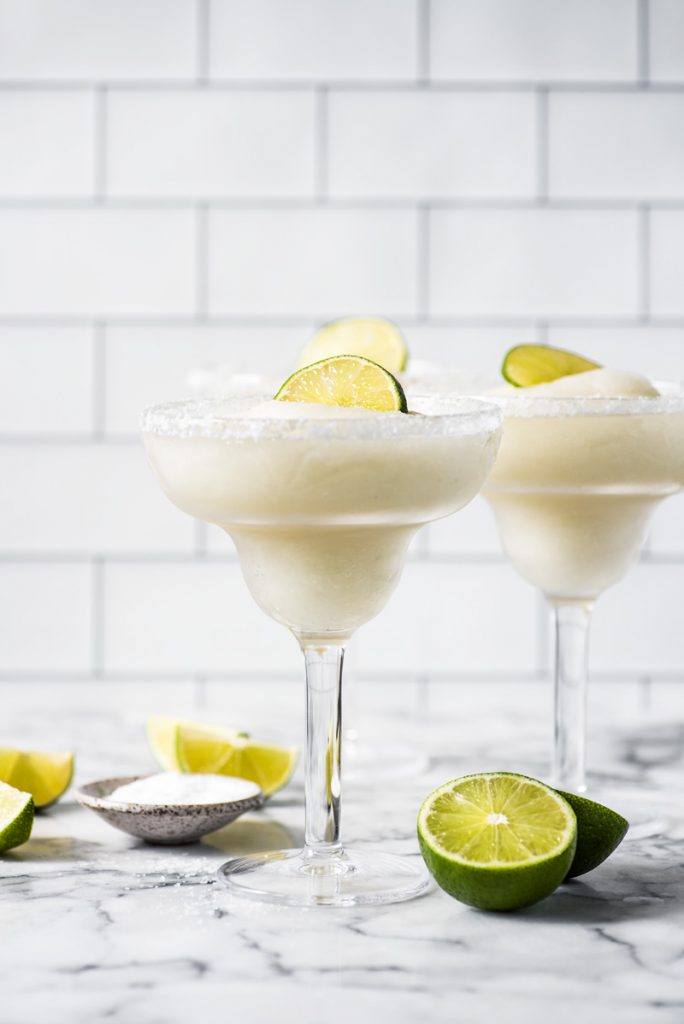
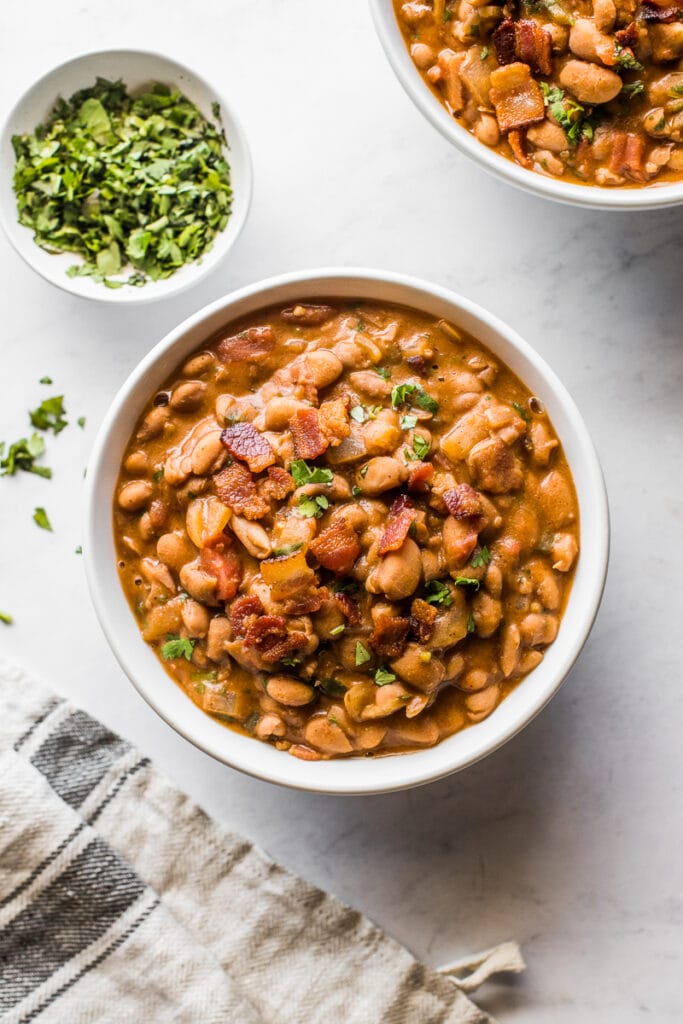
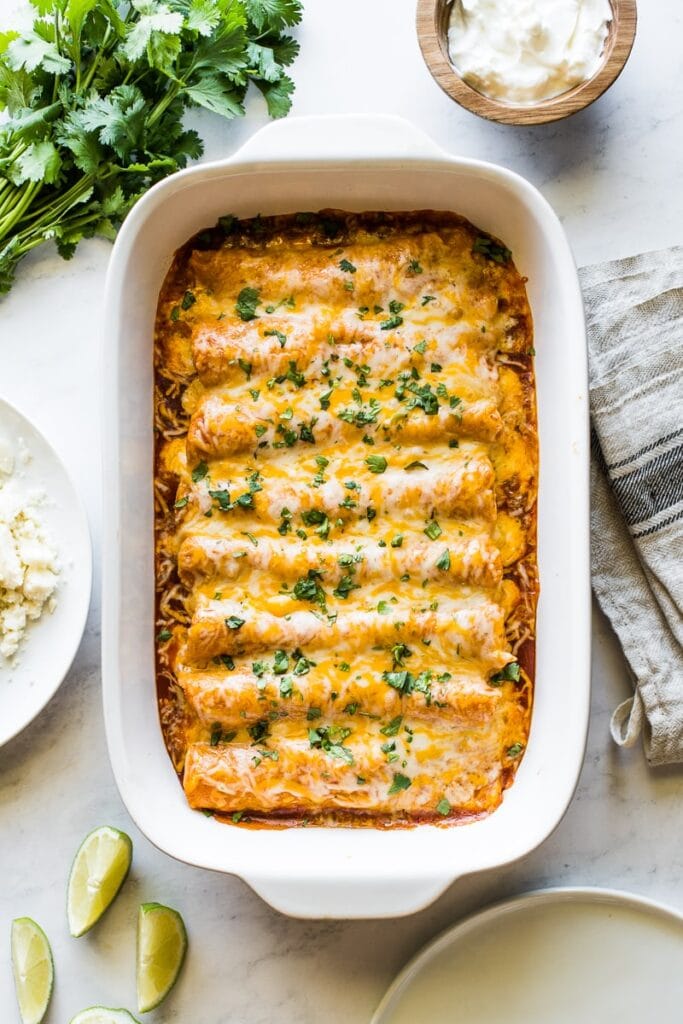
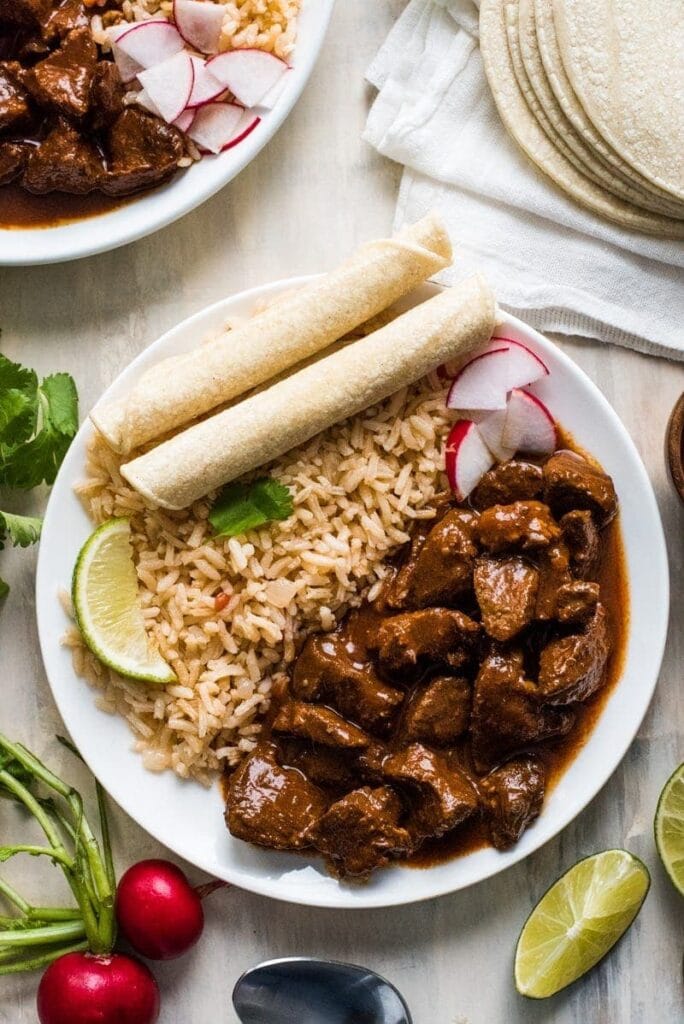






Leave a Reply